« July 2004 | Main | September 2004 »
August 31, 2004
The cell phone and dramatic life
As a tool for dramatic development, the cell phone is clearly on the in. In an earlier post we mentioned the Japanese teen supersleuth who fights crime with her cell phone every Sunday night on Japan’s BS-I channel.
Also in an earlier post, we described Sheron Wray's Textterritory, a performance in which the audience has control over physical bodies (dancers and musicians) along with lighting, music and midi system at specific times in the performance by means of their cell phones.
Here’s another, a theater work, "Two Tracks and Text Me" by Sol B. River presented at the West Yorkshire Playhouse in Leeds England in October 10 to November 1, 2003, where an SMS message plays a central role in the plot.
A young girl held captive and abused sends a desperate text-message to a stranger she hopes can help her. A hip mixed-race gang of friends receive the call, and eventually do something about it.
Nowhere near as imaginative in its use of the mobile phone as the earlier mentioned works, "Two Tracks and Text Me" none-the-less sends the message that the mobile phone is a great way to move ahead a plot that might otherwise fall on its face.
Posted by newradio at 11:50 AM | Comments (0)
imaginary and symbolic meetings
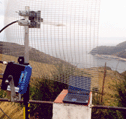
Walter Benjamin >< Marcel Duchamp
From Franck Ancel: "During a trip to Barcelona in 1997, a railway workers’ strike blocked off the French-Spanish border to me. This chance situation enabled me to explore two border villages at the feet of the Eastern Pyrenees. Two significant structures caught my attention: the Walter Benjamin memorial in Port Bou on the Spanish side called Passage by Dani Karavan, and, on the French side, the Hôtel Belvédère du Rayon Vert built by Léon Baille, the Perpignan architect.
On one side there is this memorial to Walter Benjamin who committed suicide on 26 September 1940, and on the other a building in the boat style of the 1930s containing a former cinema and theatre, listed as a 20th-century heritage building, whose name, for me, is immediately synonymous with Marcel Duchamp.
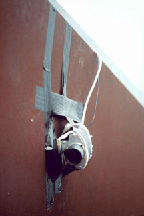 I would have to wait until the electronic projection of 23 November 2002 at the convent of La Tourette (built by Le Corbusier and Xenakis) to be able to question artistic and aesthetic boundaries in a more direct manner, in order to find out the necessary information for a search that has enabled me to talk today about these two locations in Catalogne.
I would have to wait until the electronic projection of 23 November 2002 at the convent of La Tourette (built by Le Corbusier and Xenakis) to be able to question artistic and aesthetic boundaries in a more direct manner, in order to find out the necessary information for a search that has enabled me to talk today about these two locations in Catalogne.
Benjamin’s thought and Duchamp’s art are scheduled to be brought into play during the weekend of 27 September 2003 at this Franco-Spanish border location, and this is seen as an imaginary and symbolic meeting. It is a result of, and follows, the mark that these two great figures have left behind them which has totally transformed artistic and aesthetic boundaries in the 20th century.
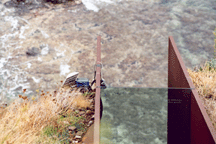
This production will cross physical boundaries and will link the two locations of Port Bou and Cerbère. In other words, the Walter Benjamin memorial in Spain and the Hôtel du Rayon vert in France. The event will attempt to mark the boundaries of the art disciplines and will be mainly held in the Hôtel’s theatre auditorium where our audiovisual reception will be held.
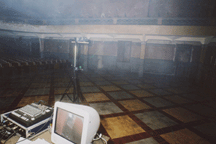
These days, it is almost considered to be an essential requirement that this comparison will use new technologies. It will therefore be through the use of wifi wireless network, together with interactive software, that we will travel beyond the physical boundary.
Our journey through and between these two locations reconnects a whole set of different information:
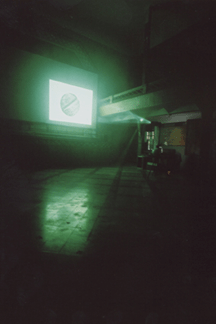
- The fictional novel Traité d’abrégé de littérature portative (Abridged Treatise on Portable Literature) by Enrique Vila Mata and published in 1985, and which depicts Duchamp and Benjamin in Port Bou as part of a secret society linked to the number 27,
- The Rayon Vert laser created by Dani Karavan for the Electra exhibition in 1983 which linked the Musée d’Art Moderne (Modern Art Museum) of Paris, the Eiffel Tower, and the Assur Tower located in the Défense quarter,
- The photograph entitled Rayon Vert by Denise Bellon for Duchamp, which was given to the set designer Frederick Kiesler, for the superstition room at the surrealist exhibition, held in Paris in 1947, the same year that Music for Duchamp was composed by John Cage.
Convergence points of the universe that have hitherto been parallel, and overlooked links, will appear at this event. This fake dimension will, however, can give another meaning to a trip, appropriate to our world, which is henceforth informational and chaotic.
This gathering consequently offers you a short-lived journey across a virtual world of concepts. It will extend the enquiry into the notion of the decline of the “aura” in the wake of computing technology, and serves as homage to Walter Benjamin."
Contact Franck at franck.ancel at wanadoo.fr
Posted by jo at 11:13 AM | Comments (0)
sms for love
same text marriage
from UPOC Networks:
On eve of the Republican Convention, Upoc Networks announces upcoming marriage of couples who met via text messaging on its mobile community service, Upoc.com. Read the press release.
Posted by at 02:17 AM | Comments (0)
August 30, 2004
Benoit Maubrey
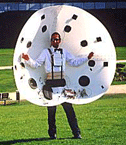
strutting and projecting his stuff
AUDIO PEACOCK is the most recent performance by Benoit Maubrey (2003). These wearable electronic instruments are constructed from polycarbonat plexigalss material shaped into a peacock's fan-like plumage. The plexiglass surface is equipped with 16 loudspeakers (150 watts power), amplifiers, and rechargeable 12 volt batteries. The "audio-plumage" is highly directional and functions like an electroacoustic radar dish--esthetically it has much in common with the way a peacock parades itself in front of the pea-hen (the audience). An Audio Peacock can either amplify its own electronic instrument and voice or receive sounds from outside sources via transmitter/receiver and disseminate them in a space by orienting his high-tech "plumage." Four Audio Peacock units can be acoustically choreographed as a mobile quadrophonic loudspeaker system.
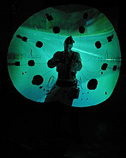 VIDEO PEACOCK: An Audio Peacock costume (constructed from white polycarbonat-plexiglass) is used as a mobile projection screen. This is a solo audio-visual concert where the electro-acoustic quality of an Audio Peacock is visually enhanced via a video beamer: moving images (both live and recorded) can be projected directly onto the performer's costume. A story is told "live" by a figurant who simultaneously samples his own amplified voice, manipulating the sound (loop and pitch): the performer dubs his own hallucogenic dream. View video (33.4 MB, Quicktime)
VIDEO PEACOCK: An Audio Peacock costume (constructed from white polycarbonat-plexiglass) is used as a mobile projection screen. This is a solo audio-visual concert where the electro-acoustic quality of an Audio Peacock is visually enhanced via a video beamer: moving images (both live and recorded) can be projected directly onto the performer's costume. A story is told "live" by a figurant who simultaneously samples his own amplified voice, manipulating the sound (loop and pitch): the performer dubs his own hallucogenic dream. View video (33.4 MB, Quicktime)
See a brief history with images of Maubrey's work.
Posted by jo at 02:00 PM | Comments (0)
Christophe Bruno
FashMobs and WiFi-SM
I came across this post on boing boing today: it suggests the possible fascist undertones of flash mobs, "depending of course on who organizes the particular gathering, their motivation..." It then refers to Christophe Bruno who has created a net art work called Global Artists. Bruno asks "Imagine that the history of the world was turned upside-down and that the historical characters who left their mark in our schoolbooks, were reincarnated as... artists. What works of art would they produce?" One example he gives is FashMobs by A.Hitler:
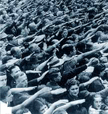 "I created a website where people can leave their mobile phone number. The idea is that when the number of people is large enough, a SMS instruction is sent to all of them simultaneously by the server. When they receive it, people have to perform the instructions. The instructions are simple ones, like raising an arm, but the effect is amplified by the fact that many people do it in the same place, at the same time, as in a symphonic orchestra."
"I created a website where people can leave their mobile phone number. The idea is that when the number of people is large enough, a SMS instruction is sent to all of them simultaneously by the server. When they receive it, people have to perform the instructions. The instructions are simple ones, like raising an arm, but the effect is amplified by the fact that many people do it in the same place, at the same time, as in a symphonic orchestra."
Similarly disturbing is WiFi-SM: Feel the Spectacle of Pain. 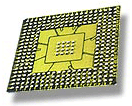 "You have the impression that the disasters of the world do not touch you anymore? You feel vaguely sorry for other people's misfortunes but you don't feel the inner urge which used to make you help your neighbour? WiFi-SM is the solution!"
"You have the impression that the disasters of the world do not touch you anymore? You feel vaguely sorry for other people's misfortunes but you don't feel the inner urge which used to make you help your neighbour? WiFi-SM is the solution!"
Bruno reminds us that, as always, technologies can be abused and/or produce the opposite effects for which they were orginally intended. Or, is this what they were orginally intended to do?
Posted by jo at 10:59 AM | Comments (1)
new questions
What is ____?
Among the questions raised by the organizers of this blog are the recurring: What is Performance? performance? performative? And within that discussion, what is authorship, interaction, participation?
As I try to get a grip on the extent to which ubiquitous/pervasive computing is already with us, I keep wondering if these questions are still relevant? Can we ask a question about today in language that resonates with earlier meanings?; with, for instance, an earlier understanding of human autonomy, separateness, centrality?

The blender responds to your yelling at it ; your 'weather coat' tells you it's going to rain; your skirt changes visual properties upon contact (see UrbanChameleon) or reacts to urban noise, or visualizes pollution and urban exhaust as it travels through the fabric. Two large handsome bowls in the park ring with sound as you move your hands around their insides, introducing a peaceful drone into a noisy environment--and then--they (the bowls) reach out and incorporate that noisy environment itself into the sound you're making–and suddenly it's all very easy to live with.
While many of these technologies may never filter down to practical or aesthetic consumer use, the number designed to alter the way we live/experience our everyday lives is truly impressive; the domestic technologies alone astonishing. From load sensitive floors, tables and shelves (www.equator.ac.uk)--to magic carpets, which have actually been around for awhile--to color-changing textiles, to responsive tools and gadgets such as Hiroshi Ishii’s musicBottles--open one and music flows; open two and the second harmonizes--to intelligent rooms and cooperative buildings--to mobile computing where computation spans a multitude of situations and locations. "Now," as William J. Mitchell writes in Me++ The Cyborg Self and the Networked City, "nothing need be without processing power, and nothing need be left unlinked." And with all these linked things and places "charged with properties traditionally associated with living bodies," (Chris Salter), how can we not reevaluate the definitions, categories, disciplines, institutions etc. by which we comprehend the world?
And shouldn't we be cautious when using language that still contains the outlines of earlier understanding to grasp today’s activities? Say the word performance and tell me you don’t immediately sense the centrality of the artist-actor?
One further thing: If you check in with a person like Neil Gershenfeld, director of MIT’s Center for Bits and Atoms, you’ll find I only scratched the surface of what's beginning to happen. He'll tell you that "we're realizing that if molecules can compute" (which he says they can), "if nature computes, you can actually use a computational language to ask nature questions of fundamental theoretical and experimental interest…" AND, "it's beginning to invert how we understand our place in the world."
I have only one solution for myself in this blog – and that is to begin a history of networked performance and of the technologies that have altered our understanding of it. Hopefully it will allow me/us to see not just what artists have already done, but how the meaning of the language we use has altered. I welcome any help I can get.
Posted by newradio at 10:33 AM | Comments (0)
August 29, 2004
tune in
www.free103point9.org
Sunday 08.29.04- Thursday 09.02.04
LIVE AROUND THE CLOCK COVERAGE OF THE PROTESTS
SURROUNDING THE REPUBLICAN NATIONAL CONVENTION
free103point9 Online Radio is partnering with
the August Sound Coalition to provide coverage of
events during the convention.
Tune in at www.free103point9.org
Posted by newradio at 11:48 AM | Comments (0)
August 28, 2004
More from the 34North folks
Jeff Knowlton and Naomi Spellman are doing a residency at The Media Centre in Huddersfield. Here's their description of what they are up to:
http://www.druh.co.uk/residencies.html
The work we are developing is an urban exploration shaped from the immediate environment and from online databases. It unfolds in realtime, through space, as the visitor makes her way through the city. The Interpretive Engine creates an audio and visual narrative, relying on the visitors' location and direction – as well as on access to wireless internet connections along the way. The Interpretive engine is a computer-based work, which can be experienced singly or in small groups, either from a visitor's own laptop, or from equipment checked out to visitors. It requires no input from the visitor, other than her natural progression through a loosely delineated space. The project takes into account local surroundings, events, and available telecommunications infrastructure.
Server side data will be parsed in real time from a variety of predetermined online resources, including a news source, a national or metropolitan historic database, a weather source, a local directory, most-wanted international criminal directory, etc. The project will parse and interpret this data, and integrate it into a site specific narrative. Key to this project is a shift in consciousness of the listener, through an exposure of something that is already always present: the [invisible] wireless network. We will encourage visitors to question how informational databases are accessed and controlled in an era of increasingly pervasive corporate and governmental control.
Posted by at 03:01 PM | Comments (0)
Bikes Against Bush

Breaking News! Josh Kinberg Arrested!
Josh Kinberg (see our Bikes Against Bush post) was arrested [watch video] while being interviewed about his Road Writer bicycle. This news comes after I personally road in Critical Mass last night and a person in our riding group was arrested. HERE IS THE EMAIL about Josh word for word:
"...about 40 minutes ago Josh was doing an interview with Ron Reagan and in the middle of it the police pulled up. 20 minutes later a captain came down to the scene (all still while on camera with Ron reagan) and after some time arrested Josh. they took the bike too. Josh is OK. We were all shocked that it would happened like that. a crowd had formed and many journalist wondered into it. Josh was little shocked but, it was all peaceful and calm just very very frustrating and absurd. - YURY GITMAN"
From | alison | juliaset, 08.28.2004: 13.19.35
Read an article.
"Joshua was released from police custody at 11:00 AM on Sunday. Lawyers from the National Lawyer Guild believe that the case is a clear violation of the first amendment and should be thrown out. Joshua's bicycle, laptop, and cell phone have all been confiscated, however, and are being held until his court hearing. The court date has been set for Friday, 9/3, after the end of the RNC. An alternative link to the video can be found at http://dv.open4all.info/?postid=70"
posted by: yatta on juliaset
Read Josh's account of what happened.
Posted by jo at 01:25 PM | Comments (0)
ubiquitous computing and the production of space

Call for WiFi.ArtCache Participants
This is a call for contributions to art-technologists interested in contributing to the WiFi.ArtCache during its exhibition at Spectropolis October 1-4, 2004. Deadline for submissions is September 26th.
By simply coding to a provided ActionScript 2.0 API, Flash artists are able to create an interactive experience that changes based on how many people have downloaded their art object, how many people are currently interacting with their art object, or whether their art object is currently in range of the WiFi.ArtCache. Here are earlier posts about WiFi.ArtCache and Spectropolis.
The WiFi.ArtCache is a physical object server containing a standard WiFi 802.11 access point. When exhibited at the Spectropolis event at New York's City Hall Park in Lower Manhattan, the WiFi.ArtCache will contain a storehouse of art objects. Visitors to the event can download these art objects onto their 802.11 equipped laptops and experience the artists' interpretation of location and proximity effects.
Developer documentation and downloads can be found at:
http://wifiartcache.techkwondo.com/overview.jsp
http://artcache.techkwondo.com/overview.jsp
Please send submissions, questions and inquiries to wifiartcache at
techkwondo dot com.
General information about the WiFi.ArtCache concept can be found at:
http://www.techkwondo.com/projects/artcache/
Additionally, the WiFi.ArtCache will contain a generic storehouse of digital ephemera that visitors can upload and download to the server. Scratchy audio, yellowed digital documents, discolored image files and spoiled emails can all be found and dropped off at the WiFi.ArtCache.
WiFi.ArtCache was developed by Julian Bleecker with support from Eyebeam Atelier. This exhibition is sponsored by the Downtown Alliance, NYCWireless, the Lower Manhattan Cultural Council and Spectropolis. Spectropolis is curated by Wayne Ashley, Yury Gitman and Brooke Singer.
http://spectropolis.info
http://www.techkwondo.com/projects/artcache
http://www.eyebeam.org
http://www.nycwireless.org
http://www.lmcc.net
Posted by jo at 10:57 AM | Comments (0)
humanistic front
live from South Africa
A few weeks ago, I blogged a piece called front, by, among other artists, Ralph Borland - a South African sculptor. Some of his response to me, over email:
in the spirit of blogging, i'll tell you what i've got into lately that relates to front. i picked up a book called "the anatomy of human destructiveness" in a second-hand book store in observatory on the weekend. the photographer pieter hugo was with me and he recommended it as one of the best books he's read. it was written in the early 70s, and is an investigation by psychologist eric fromm into the question of humanity's instincts or tendencies: are they towards aggression and violence - is that the underlying cause of war and cruelty?
he's in part countering a book which came out a few years before, the animal behaviourist konrad lorenz's "on aggression", which we - the millefiore effect - have referred to in documentation about front. fromm criticizes lorenz for making no distinction between defensive or functional aggression, and cruel and destructive aggression, which allowed lorenz to find cause for our warlike tendencies in our nature and instinct. fromm takes a harder look at the question. i like his character; he's a humanist and an insightful analyst, who demonstrates the social and politic colouring of scientific enquiry. he argues against the essentially pessimistic notion that we tend towards war or cruelty. the question of our 'natural' tendencies is a crucial one if you're interested in non authoritarian and non hierarchical alternatives for human organisation, as i am. the question of what a society without authority would look like, is a challenging and complex one. i'm enjoying this book. (Posted by Nathaniel Stern)
Posted by at 05:25 AM | Comments (0)
August 27, 2004
SPEAKERS CORNER

dialogue between the street, the web and people's mobile phones
From "Interactive Street Interface" by Jaap De Jonge: Speakers Corner is a 15 metre long interactive LED text display fixed to the outside of The Media Centre in Huddersfield. Running 24 hours a day, 365 days a year, Speakers Corner will display a wide range of content, information and news, providing entertainment and services to people using The Media Centre and the local area.
Users can interact with content on the screen in three ways by sending a text message, by using the phone booth outside The Media Centre which converts speech into text, or by adding comments from the web at www.speakerscorner.org.uk. Users' comments are then archived in the database and sent to the display, building a dialogue between the street, the web and people's mobile phones.
Read more at Patrick Lichty's [re]distributions.
Posted by jo at 10:20 AM | Comments (0)
more for de feet
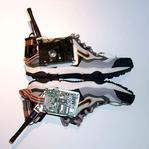
The Sensor Shoe
by John Paradiso
Ordinarily dancers dance to music. With the Sensor Shoe the dancer makes the music.
Electronic sensors are built into this ordinary shoe to pick up foot movement and changes in pressure. The short antenna at the back of the shoe transmits data from each sensor to a nearby computer. The computer is programmed with a set of rules that map the data to particular sounds. A digital music synthesizer produces the sounds, which are then heard through speakers.
See NY dancer Mark Haim dance in the sensor shoes (2001)
Posted by newradio at 09:59 AM | Comments (0)
magical footwear
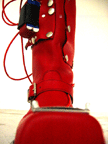
Seven Mile Boots
Seven Mile Boots,
"...the magical footwear known from folk tales that enables its owner to travel seven miles with one step. With little effort one can cross the countries, to be present wherever it seems suitable and to become a cosmopolitan flaneur with the world as the street."
The project Seven Mile Boots is a pair of interactive shoes with audio. One can wear the boots, walk around as a flaneur simultaneousy in the physical world and in the literal world of the internet. By walking in the physical world one may suddenly encounter a group of people chatting in real time in the virtual world. The chats are heard as a spoken text coming from the boots. Wherever you are with the boots, the physical and the virtual worlds merge...The site contains a short bibliography on the "flâneur."
Posted by newradio at 09:58 AM | Comments (0)
August 26, 2004
PING

Presence and Absence
PING, by Kate Armstrong, uses a telephone menu system to distribute active commands to participants who call in using cellular telephones. The choices made by the caller when navigating the telephone system produce directions for physical movement through the city.
PING comes out of psychogeographical inquiry, which focuses on the study of the effects of the environment on the perception, behaviour and mood of individuals. PING is intended to explore the interface between disparate fields such as situationist thought that focuses on subjective mood, generative psychogeography which introduces algorithms as a way to inspire movement through urban space, existentialism, and the interpolation of digital metaphors onto physical, analog space. Read "A Psychogeographical Account of PING and the PsyGeoConflux 2003" by Kate Armstrong.
Posted by jo at 11:08 AM | Comments (0)
August 25, 2004
Poetrica

Teleintervention
Poetrica is an investigation about reading and reception in cybrid and entropy situations. The project involves a series of visual poems conceived by Giselle Beiguelman with non-phonetic fonts (dings and system fonts), a DVD, digital prints, movie trailers and a teleintervention which allowed to anyone compose visual messages and submit them, by the Web or SMS, to three commercial electronic billboards located in downtown São Paulo, using the same typographic background she used in her nomadic poems.
Posted by jo at 07:51 PM
iki-iki phone
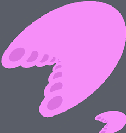
IKI-IKI Hoikuen
"IKI-IKI Phone is a multi-user, networked Artificial Life (=Alife) art game for the I-mode mobile phones. In this system, subscribed users can create Artificial Life creatures (=IKI-IKI pets), interact with these pets, feed them, take care of them, and evolve them. Networked users can also share their pets with other mobile phones users, trade them, watch them compete against each other, become friends with each other, create offspring and develop an IKI-IKI pet society. Users can also start communicating with each other through their shared pets."
A collaboration between Alan Dorin, Christa Sommerer, Laurent Mignonneau and the students of the Institute for Advanced Media Art & Sciences (IAMAS), Ogaki, Gifu, Japan. Read "IKI-IKI Phone: a Multi-user Alife Art Game for Mobile Phones."
Posted by jo at 06:30 PM | Comments (0)
The Relational Aesthetic
From an essay written for Camerawork: A Journal of Photographic Arts by Matt Locke:
[A story about Uncle Roy All Around You by Blast Theory; A story about Surrender Control by Tim Etchells; and A story about Audit by Lucy Kimbell]
"Those stories describe three interactions. Or performances. Or moments in the production, or consumption, of an artwork. Or perhaps they are descriptions of how the production and consumption of an artwork can be reduced to the same act, the same moment. They operate within, to use Nicholas Bourriaud's term, a 'relational aesthetic' - these artworks don't rely on an encounter with a traditional art object, nor do they substitute that with some transcendent concept of a dematerialised art object. In Bourriaud's definition, these works exist within "the realm of human interactions and its social context, rather than the assertion of an independent and private symbolic space". They are moments to be experienced, not viewed, reaching out and enmeshing themselves in the messy network of conversations and relationships that make up your life." Continue reading.
Posted by jo at 05:45 PM | Comments (0)
contagion
Jill of Jill/txt has observed a new kind of narrative emerging from the net, what she calls "distributed narrative" or "viral narrative" or sometimes, "contagious narrative." It's narrative that doesn't try to be a total or complete artwork but sends "fragments and shards across media, through the network and sometimes into the physical spaces that we live in." It's a "book without end." She likens it to distributed computing, which spreads processing across many computers, attaining as much or more power than is possible in a single supercomputer.
Jill references Tim Etchell's (see also Forced Entertainment) work, Surrender Control, where the reader receives SMSs asking her to do things that carry the narrative into her physical world.
So with "viral narrative." It asks the reader to take it up and pass it on to places it has never been. To become a performer on its behalf.
Jill will be writing more about this viral narrative in the upcoming months.
Posted by newradio at 11:47 AM | Comments (0)
texting glances
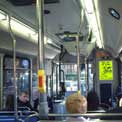
interludes from the cityscape
A collaboration between the networks and telecommunications research group at Trinity College, and the Media Lab Europe - both based in Dublin - this project uses the city as a place to perform narratives with your mobile phone. Viewers can MMS to upload images from around them into a live database, or, by SMSing keywords, download snaps from the archive at any time. more info
(Posted by Nathaniel Stern)Posted by at 10:44 AM | Comments (0)
more on mobile
Here are a couple of books on mobile phones:
1. Perpetual Contact: Mobile Communications, Private Talk, Public Performance, edited by James E. Katz and Mark Aakhus. This book deals with the impact of mobile phones on contemporary society from Finland to the Phillipines. Published in 2002, its information probably needs an update.
2.The Mobile Connection: The Cell Phone's Impact on Society by Rich Ling. Howard Rheingold calls it "a sound introduction to the social study of mobile phones, arguing among other points that SMS faces a bleak future. Published in 2004.
Earlier posts on the impact of the cell phone include: Ketai and Yo kidda NuOK.
Posted by newradio at 10:08 AM | Comments (0)
August 24, 2004
Musicians and mobilephones
"Musicians have subverted tools such as the record turntable, the digital sampler and the laptop computer, transforming them from their original purposes into instruments. Ringtones were the obvious starting point for the mobile phone as a creative device. In 2002, the Touch label released "Ringtones," a CD collection of sounds commissioned or collected from 99 artists and sources, ranging from Gilbert and George to sound recordist Doug Quin's tapes of arrow frog and baboon..."
For more of this great short history of musicians use of mobile phones, see
Walking Through Sound by David Troop. It's a great article.
Posted by newradio at 06:33 PM | Comments (0)
Media Psychosis
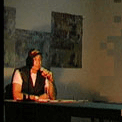
Live Rant
Rant/Rant Back/Back Rant, by G.H. Hovagimyan and Peter Sinclair, samples and re-mixes news report catch-phrases cycling through the global information environment. The work looks at the use of targeted language within the framework of mass media, and posits a media overload psychosis embodied by the live performance word jam created by Sinclair and Hovagimyan. Two live performances will be performed at Groningen Museum and STEIM, Netherlands and streamed live on August 23rd and August 26th.
Peter Sinclair and G.H. Hovagimyan have been artistic collaborators over a number of digital performance and installation works. Mr. Sinclair who is a well-known sound artist lives in Marseille, France while Mr. Hovagimyan who is a multi-media artist lives in New York City.
Sinclair’s works have recently been highlighted in the French contemporary art magazine artpress. (Art Press special edition, number 24, 2003. Le Burlesque. Une Aventure Moderne.) One work, A SoaPOPera for iMacs done in collaboration with Hovagimyan will be included in a historic exhibition called Le Burlesque that will be on view in Paris at the National Galeries Jeu du Paume Museum in 2005. Documentation and video of this work can be seen at: http://nujus.net/gh_04/gallery3.html
Part of the inspiration for the work Rant/ Rant Back/ Back Rant developed out of xenophobic rants that Sinclair encouraged Hovagimyan to do for their 2001 Interactive sound and laser installation work titled Shooter. You may view documentation and video here: http://nujus.net/shooter-new-site/index.html
Their latest work Rant/Rant Back/ Back Rant will be performed in the Netherlands at the Groningen Museum, August 23rd and August 26th at STEIM, Amsterdam.
While investigating synthetic voice programming in 1996 Hovagimyan met Peter Sinclair. The two began to collaborate on a series of works that used text and synthetic voice as an element for robotic performance and installation work. Sinclair brings to the collaboration a fascination with the mechanic possibilities inherent in programming and digital art as well as his expertise in the realm of sound art and performance works. Indeed, before meeting Hovagimyan, Sinclair was quite accomplished as a performance artist in France. A survey of his works can be seen at: http://www.nujus.net/peterhomepage/html/
Hovagimyan brings to the piece a long history of using text within his work both individually and in collaboration with Sinclair. In 1994 Hovagimyan did a billboard campaign for Creative Time in New York City. The billboard , Hey Bozo… Use Mass Transit, used a block of text somewhat in the manner of rap lyrics. Documentation as well as an NBC news report can be seen
at: http://nujus.net/gh_04/gallery2.html
In 2000-2001 Hovagimyan created a series of rant performances for the palm pilot called Palm Rants. Documentation can be viewed at: http://nujus.net/gh/html/rants.html. An example can be seen at http://nujus.net/gh_04/video/entertainMenow.mov
As far back as 1974 Hovagimyan has been using agit-prop as part of his work. Indeed a 1974 work Tactics for Survival in the New Culture was shown in a 1978 group show called Manifesto organized by Collaborative Projects in New York City. Subsequently, in 1994, Hovagimyan updated the piece, turning it into a hypertext work and one of the earliest examples of what is now known as Net Art. The work can be viewed online at: http://www.thing.net/~gh/artdirect/tactics.html
Their collaborative works as well as their homepages can be accessed via the web at: http://nujus.net (note the site uses pop-up windows and javascript. Enable scripting and pop-up windows to view the site)
Posted by jo at 11:28 AM | Comments (1)
author your own
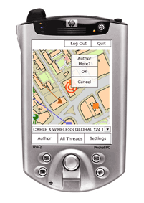
Urban Tapestries
Urban Tapestries is "an experimental location based wireless platform that allows users to access and author location-specific content (text, audio, pictures and movie)." Initially created by artists, the project rejects the template of conventional tourist guides in favour of public authoring informed by local knowledge and shared experience. It seeks to enable people as their own authors and agents, to ‘map’ and 'mark’ territory as part of belonging and of feeling a sense of ownership in their own environment.
"The structure of the art world is a world in which you go to a place to receive an experience," Giles Lane, one of the developers of the London-based says. In the future, artists will still be important for their spark, but the balance will shift from a push model to a more engaged, multi-directional relationship." (from receiver "Walking Through Sound" by David Toop.)
They recently ran a 4-week free trial of of the Symbian UIQ smartphone version of UT in London and will be reporting on it shortly. They hope it will provide interesting information on public authoring technologies, reveal uses to which they have already been put, and allow new uses to emerge.
For more information, see Giles Lane, Social Tapestries: public authoring and civil society
Posted by newradio at 10:05 AM | Comments (4)
More RNC
There are already lots of projects out there that respond to the RNC. You might want to check back on John Perry Barlow's Dancing in the Streets or TXT mob, a free service that lets you share messsages with others during the convention. Or take a look at: Free Speech TV, moport, CoDeck, or politics.technorati.com, which is keeping an election watch, and indymedia and their march from Boston to NYC. There are others -- all creating spaces for independent expression. As the Screensavers say, "There are going to be thousands of people textblogging, audioblogging, videoblogging, photoblogging the RNC, most with RSS feeds and most with open content licensing. RSS (Really Simple Syndication) is a web syndication protocol that is primarily used by news websites and weblogs. There is going to be all of this RSSified RNC content sitting out there ripe for cultural/artistic aggregation."
Good luck to all!
Posted by newradio at 10:04 AM | Comments (0)
RNC-Redux

Screensavers
Each night of the RNC, Screensavers, a media collective that uses developing technologies and digital art in public social systems to generate, disrupt and synthesize the socio-political landscape, in association with the Thing will present the RNC Redux Open Doc Tour, a real time performance created by pulling a broad selection of the day's blog text, photos, audio, and video to mix it into a narrative of the day's events. One of Screensavers’ principal interests is to leverage synergistic energy, building off of existing events and capturing real time content streams to transform public expression and awareness around timely issues. This live, collective documentary will be generated through a gestalt remix of rich 'personal is public' content.
See Schedule
Posted by newradio at 09:54 AM | Comments (0)
August 23, 2004
Dissension Convention
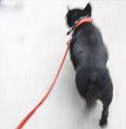
A Transatlantic Collaborative
Multimedia Protest Jam
Dissension Convention will coincide with the Republican Convention in New York. 10 pairs of net/digital artists from the Americas and Europe will create live, online multimedia performances. These will be projected at RNC NODE Postmasters Gallery, as well as by other appointed NY platforms in 'store windows, bars.'
5 days of live mix performances, online in real-time from 29th August-2nd September between 12noon and 6pm (NY time) via Furtherfield's VisitorsStudio.
If you are viewing from home you can visit versions mirrored on the artists' websites (check project URL for updates).
* If you wish to mirror this event on your site please target this file http://www.furtherstudio.org/live/dissensionconvention.swf
Programme Participants:
Sunday 29th August
4-7pm NY (9-12pm BST) *Maya Kalogera & Marc Garrett*
7-10pm NY (12-3am BST) *Moport.org & Glowlab.org*
Monday 30th August
4-7pm NY (9-12pm BST) *Chris Webb & Sim (Soy.de)*
7-10pm NY (12-3am BST) *Lewis Lacook & Alan Sondheim, Sheila Murphy & Jason Nelson*
Tuesday 31st August
4-7pm NY (9-12pm BST) *Helen Varley Jamieson & Karla Ptacek*
7-10pm NY (12-3am BST) *Joseph and Donna McElroy*
Wednesday 1st September
4-7pm NY (9-12pm BST) *Neil Jenkins & Roger Mills*
7-10pm NY (12-3am BST) *Digitofagia vs. Autolabs*
Thursday 2nd September
4-7pm NY (9-12pm BST) *Michael Szpakowski & Ruth Catlow*
7-10pm NY (12-3am BST) *Ryan Griffis & Mark Cooley*
Postmasters Gallery is creating RNC NODE, a way-station, serving as a physical node of an ad-hock public broadcasting, a system of online, real time protest performances and alternative news actions. All online streams will also be output in local bars and projections from windows. Dissension Convention will be part of this programme.
DissensionConvention is a Furtherfield project.
Posted by jo at 10:06 AM | Comments (0)
August 22, 2004
Avalon

space to think and dream
Avalon, brought to you by Second Life™, offers a variety of products, tutorials, and even a competition. Select from the Mrs. Jones or Sultana fashions, or download the Beginner's Guide to Clothing and Building in Second Life®. Second Life is "one of the most innovative, multiuser environments developed in the last decade..." Unlike recent MMORPGs like Everquest and Ultima Online, Second Life's users create and develop their own goals and content, and are writing their own history.
Posted by jo at 06:42 PM | Comments (0)
Jane's blog

Blogging, for Real?
Hi, I’m Jane and I’m an 18 year old supermodel from the Ukraine. I’m lying, I’m a 28 year old hair stylist from Minnesota...I’m really psyched to share my blog with you guys...and if you have something to share with me, go for it! especially if you have a cute brother or know where to find a great hamburger. xo, J (by the way, I’m not actually real, I’m a fictitious character on the TV series Good Girls Don't. But that won’t stop me from writing to you every day. I mean, every weekday. Cause on weekends I’m in party mode.)
Via "Jonah Peretti and Jane's Blog", 16:26 JST » Blogging about Blogging-Joi's Ito's Diary
Posted by jo at 01:02 PM | Comments (0)
August 21, 2004
tell it all
Computer couture is all the rage these days. HorizonZero’s July issue focuses on "smart clothes" and "fashionable technologies." Banff’s Sara Diamond and Joanna Berzowska, Assistant Professor of Design and Digital Image/Sound at Concordia University, Canada, whose "Intimate Electronics" can be found in HorizonZero’s July issue are both at ISEA. We’re bound to hear more and more about the latest developments in this long history of prostheses, which probably had its beginning with efforts to improve eyesight. (Roger Bacon made the first recorded reference to lenses for optical purposes in 1268; in 1665, Robert Hooke called for inventions to improve our other senses. See A brief history of wearable computing. And we’ve been at it ever since.
But now it’s not the eyes but a pair of jackets that broadcast and respond to "their other half" by wireless signals. Yes, and make sounds like crickets mating when they find one another! Or, reactive garments that display their history of use. There’s high drama embedded in this stuff!
But also serious concerns.
While the recent exhibition DIS2004 in Cambridge, MA (USA), was not focused on clothing, it contained one wearable item in which concern was expressed for the overall impact of mobile communication: Fashion Victims by Italian artists Davide Agnelli, Dario Buzzini and Tal Drori. Mobile communication devices bring with them "a number of social consequences, most of which are still invisible, hard to map and to explain." In Fashion Victims the artists designed a collection of garments that react to surrounding mobile phone calls in order to make a part of the invisible visible. As more phone calls are conducted in their surroundings, the clothes "progressively and permanently change color." By producing a physical result they call attention to the "pervasiveness and intrusiveness" of the mobile phone – its tendency to "violate the private space we potentially have within the public context."
Another wearable, WiFisense (currently, a handbag with 64 LEDs embedded in the front) does something similar--it detects open wireless networks and uses patterns of light and sound to announce their availability, quality and accessibility.
Still, it seems far less likely to this blogger that cautionary clothing will find commercial support than clothing that extends the private into the public. It's the direction we Americans have opted for since radio and television first caught the public imagination.
And when in 2001 the Defense Advanced Research Projects Agency jump-started a project to accelerate the development of electronic textiles, one of its beneficiaries was MIT Media Lab graduate Maggie Orth, co-founder of International Fashion Machines (IFM) and someone taking clothing in that direction.
IFM’s proprietary electronic textiles include Electric Plaid, (color change textile technology) and StitchSwitch, (textile sensing technology). Combine them and you can create fully interactive textiles and artworks. Which means, among other things, you can change the color of your clothing or the interior of your house to match your mood. Read more
So I’d count on clothing that tells more and more about you. With your clothes giving you away, pretending may be hard .
Why we should be interested in this – and I think we should – will be the subject of another blog. And I'm hoping we can get some discussion going on it.
Posted by newradio at 12:35 PM | Comments (0)
Demonstrate
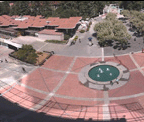
Emergent Opinion
On September 1, a team at UC Berkeley led by Ken Goldberg will reveal the world's most advanced webcamera. Dubbed Demonstrate, the camera allows anyone online to watch what's happening at Berkeley's Sproul Plaza, the birthplace of Free Speech Movement in 1964. The student movement will celebrate its 40th anniversary this coming month.
Users are able to control the camera, capture and post photographs and write comments for one another. Among crowds, juries, and voters, opinion emerges from a dynamic interplay of actions and influences.
Posted by jo at 11:35 AM | Comments (0)
ultra modern - very social
Another Motherboard project, ultra modern - very social is a streaming theatre concept for 2002 and beyond. This space is dedicated to the pursuit of experimental theatre which is somehow modulated and mediated by the intermediary influences of the net, but may also involve communcation appliances such as telephones, mobile phones, walkie-talkies, radio, etc. Our emphasis is on improvisation and experimentation where "here and now" and "there and then" are relative expressions in collaborative networked spaces.
Posted by jo at 11:31 AM | Comments (0)
Mobile Communication, Private Talk, Public Performance
Posted by jo at 10:53 AM | Comments (0)
August 20, 2004
arm wrestling
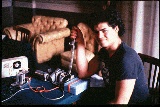
Telephonic Arm Wrestling
1986:
The setting was a bar-room. Two Canadian artists—Doug Back and Norman White -- were talking about the arms race.
"Wouldn't it be great," Back said, "if [the arms race] could be resolved by arm wrestling?"
And so the idea grew, “to allow contestants in two different cities to arm wrestle, using motorized force-transmitting systems interconnected by a telephone data link." Information would flow bi-directionally -- between identical robotic arms controlled by active agents at each of two sites.
After engineers at the University of Toronto estimated a cost of $75,000, the artists decided to try to build it themselves, and did. in two months for approximately $500 by throwing together “a bunch of junk" along with some homemade custom electronics.
The first successful implementation of the work took place between the Canadian Cultural Centre in Paris and the Artculture Resource Centre in Toronto.
Telephonic Arm Wrestling wryly established a low-tech system for resolving competitive, if not antagonistic relations. It was remarkably sensitive. "You could almost feel the pulse of the other person,” White said, “... it was uncannily human-like--the sensation of sinews and muscle--not at all like feeling a machine."
Because of the time-delays in the telephone link, the system could not support standard rules of engagement. It was impossible for the competitors to really have much of a fight. Under certain circumstances, both sides could win simultaneously, fundamentally undermining the competitive model of win-lose. In this case, there was no victor, only local perceptions, a telling commentary on the arms race and the opposition of capitalism and communism.
from looksmart "Tele-Agency: Telematics, Telerobotics, and the Art of Meaning" by Edward A. Shanken.
Other works (1969-1996) by Norman White
Posted by newradio at 05:46 PM | Comments (0)
murder
Those were the themes in an interactive, fictitious murder mystery and sightseeing tour developed by four graduates of the Canadia Film Centre's Habitat Lab, Toronto. The idea was to let participants tour the neighborhood while at the same time trying to solve the mystery. En route they visited the Gladstone and Drake Hotels, the Beaver Cafe and the DeLeon White Gallery, gathering clues and directions by dialing their cellphones, reading text messages, and examining physical evidence and computer displays at different sites.
The mystery/sightseeing tour was a prototype. It lasted only two days, but interesting developments were expected. Regrettably Ian Harvey, a journalist and one of the project's producers was the only person named in the Globe article.
Posted by newradio at 05:26 PM | Comments (2)
Motherboard
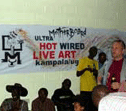
Ultra Hot Wired Live Art
In February 2003 a group of artists from Norway, Germany, Holland, Canada, England and Austria, working together on a project called Ultra Hot Wired Live Art initiated by Motherboard and BEK traveled to Kampala with 15 powerful Macintosh computers in their baggage. The aim was to create African computer art in an attempt to answer Brian Eno's question: "How can you africanize a computer"?
In collaboration with over twenty artists and musicians in Uganda, the artists held a workshop to share competencies in music and art production that utilize digital tools and the Internet. This was to develop a social and technical infrastructure for the creation of networked performances and future collaborations. More info
Posted by jo at 04:10 PM | Comments (0)
Responsive video jewellery
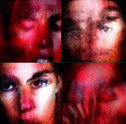
Capturing Neuroses
Medulla Intimata introduces a new form of non-verbal communicaton in the form of responsive video jewellery. Video displayed on a screen embedded in the jewellery is generated in real-time in response to the wearer's emotional state by monitoring the dynamics of conversations in which they are engaged.
Medulla Intimata explores social performance. Every interaction in a social setting starts as a performance of selves, a formal dance of introduction and a search for expression. Medulla Intimata provides a medium in which to visualise this informal social performance, allowing the interactors to monitor and feed off their mutual performance, and others to act as sporadic audience. Read more.
Posted by jo at 12:05 PM | Comments (0)
where are we eating?

Digesting Sound
where are we eating? is a translocal radio feast. Site-specific dining at ISEA 2004 and around the world. This is a project which aims to nourish. "We are interested in exploring hybrid transmission spaces dispersed and mobile modes of exchange, eating as a particpatory performance, cooking as a collaborative creation."
where are we eating? radio feast will be broadcast on 21-22 August 2004 on ÄÄNIRADIO 103.1 FM, online and on the streets of Helsinki where Grilli Radio will explore the local foodscape.
Posted by jo at 11:52 AM | Comments (1)
Un Message, Evidemment...
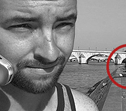
Cell phone portraits
Un Message... is an ongoing film and performance. The performance actions are built around the activity of making an interactive collaborative film. The film is a story about communication. The performance is a communication about story.
The film is already shot. The film has not been written. The film will be written through mobile phone lines, voice messages, sms’s, email, conversations, random overheard snatches of dialogue and any other sounds produced by the participants of various festivals, seminars, workshops and by visitors to this web site.
Posted by jo at 11:20 AM | Comments (0)
help me make it through the night

Acting Out
help me make it through the night, brought to you by the Gob Squad...
"In the blue, dead hours of night, four people return to their hotel rooms. None of them can sleep, instead they kill time in cold baths or by finding comfort in the solace of the hotel mini bar. Each is being watched by a surveillance camera, sharing their moments of fear and boredom as they sit out a long and sleepless night. In the conference room of the hotel the audience watches the four performers on a fourway split screen projection. In the anonymity and discretion of the hotel environment the performers will enact forbidden games and unlived desires at the request of the audience."
Posted by jo at 02:00 AM | Comments (0)
August 19, 2004
Active Ingredient
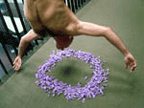
New Moon Radio
Active Ingredient have been creating exciting and innovative projects since 1996. Their work has included: Chemical Garden, “A modular garden built in units containing strange plant life and internet controlled robots”; Ghost Engine, a live online séance; Big Up Yourself, a participatory project working with Galleries of Justice.
Moon Radio, begun in 2000, has hosted many live broadcasts, new films and commissioned projects. All New Moon Radio... marks a new era for the project, reflecting the changing pattern of innovation on the web. Now at the heart of the project is the audience - their web community – interactivity and participation. Using chat rooms, SMS texting, community profiles (…and coming soon artist Blogs) Moon Radio aims to become a space that is alive with debate, activity and new projects, reflecting the audiences needs and desires.
Posted by jo at 11:42 AM | Comments (0)
trans/forms
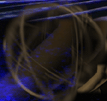
Mixed Improv
trans/forms is an ongoing multimedia collaborative project exploring the fusion of live performance with digital technology and on-line communication from an improvisational perspective. Its first performance event, including live movement and sound as well as digital video and netcasting, was presented as part of International Dance and Technology 99 (Arizona) in 26 February 1999. The material for this performance was produced in three different places of the world: Tempe, Arizona, USA (movement, sound and video contributions), London,UK (sound) and Turku, Finland (video). It was mixed live on the web. Read a paper by Sophia Lycouris. Other works by kunstwerk-blend
Posted by jo at 11:16 AM
New Work Network
New Work Network is a sector-wide, artist-led organisation that brings together artists, producers, venues, academics and other practitioners involved in the new work sector in the UK. The organisation builds on the existing cross-over between a wide variety of practices in the fields of performance, live art, new theatre, new dance, installation, video art, digital art, time-based and interdisciplinary arts including those that embrace new technologies.
Their project "Networked Bodies"is a radical and democratic awards scheme for the creation of new work in the live medium. It hands decision-making back to you - the artists, producers, critics and academics via a unique, online submission, review, discussion and voting process.
In 2004 Networked Bodies will offer 3 awards of £5000 for the production of new work to professional artists working in Live Art, live/interdisciplinary practice and contemporary performance and it offers New Work Network's membership the opportunity to discuss and decide who should get awards. Winning projects must be produced and shown at least once in England by the end of the financial year in which the round takes place.
Posted by jo at 10:36 AM
Bodies in Flight

skinworks
Bodies in Flight make performances with new technologies in cutting edge venues that challenge and re-energize the conventional relationship between audiences and performers, and audiences and place. In skinworks, 2 handles appear in a chatroom; they’re anonymous, they’re anybody, everybody, they’re angels, demons, they’re hermaphrodites; they’re making a new kind of love, mailing valentines into the void. Three performers cruise the web, crashing chatrooms, flipping identities, spinning yarns, beguiling, ensnaring unsuspecting novices, seducing each other, pushing imagination beyond the tech spec.
Posted by jo at 09:25 AM | Comments (0)
August 18, 2004
play that space
Intelligent Street
Intelligent Street by the Swedish/UK group Ambigence is a multi-space interactive sound installation that processes text message commands sent via mobile phones to create an ever-changing musical composition. The text commands determine the mood, energy and style of the music. The intention is to use the music to create a more flexible space and a more stimulating environment, where the users of the space become the co-creators of the musical composition.
iHiFi-the intelligent hi fi
iHiFi by the Ambigence group is an extension of the domestic hifi and is used in a domestic environment to provide music as a source of entertainment according to taste, mood and user activity. Unlike a standard hifi it has an intelligence that gives it a flexibility to change and adapt the content of the music to provide a personalised or enriched experience for the user. The idea is to create not consume. The catch may be that you have to buy it first.
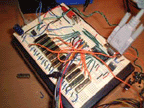
Speaker Phone
Jonah Brucker Cohen did something similar to this with his SpeakerPhone project where a sequence of individually addressable speakers could be controlled with a mobile phone and sound targeted instantly to a precise location and to travel along a path. The project enables a range of presence applications including the creation of highly customized spatial soundscapes and the transmission and layering of sound information across multiple locations in space or time.
Posted by jo at 07:18 PM | Comments (0)
play that city

Sonic City
Sonic City, the artists write, is a project exploring mobile interaction and wearable technology for everyday music creation. We have designed, implemented and evaluated a system that creates electronic music based on sensing bodily and environmental factors. Mapping these to the real-time processing of concrete sounds, Sonic City generates a personal soundscape co-produced by physical movement, local activity, and urban ambiance. Encounters, events, architecture, (mis)behaviours – all become means of interacting with or 'playing the city'.
In this project, our intention is to break out of traditional contexts for music creation to explore creative possibilities within local surroundings and mundane activities. Wearing Sonic City, anyone can experience a simple walk down the street as an expressive act, a path through the city as a personal composition. As a complement to lived urban experience, it is an intimate soundscape intended to enhance perception and encourage new uses of the urban landscape.
Posted by newradio at 07:17 PM | Comments (0)
coffee and avatar, please
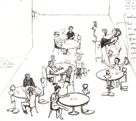
The Chit Chat Club
It will be a real cafe, with real tables, real coffee and pastries...some of the chairs will be regular chairs;... others will be seats for avatars, equipped with monitors and network connections...There are multiple ways to interact ... in the Chit Chat Club. As in an ordinary cafe, people can walk into the physical Chit Chat Club space, order a coffee, sit down and talk with others and people watch. One can also enter the Chit Chat Club remotely through the website and occupy an avatar chair. This action opens a real-time two-way audio and graphical connection between the physical space and the online participant. Finally, a person physically present in the Chit Chat Club space may also occupy an avatar chair.
Sounds fun to me. Check out the website
Posted by newradio at 05:47 PM | Comments (0)
neuroTransmitter [nT]
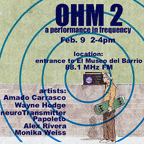
Through the Membrane
Founded in 2001, nT is a radio collaborative utilizing analog communication technologies. Working specifically with radio machinations, neuroTransmitter propels signals through urban membranes and cellular formations. To complement their fixed and mobile frequency performances, nT creates radio-sonic installations, produces music, and converts utilitarian objects into radio transmission and receiving devices. Projects include:
PUBLIC_RADIO connects the newspaper dispenser with the airwaves altering public expectation and engagement with the dispensing object. From July 20-21, 2002 as part of the Dispensing with Formalities series, a live radio transmission was performed and broadcasted in the vicinity of public_radio.
com_muni_port--is a portable radio broadcast unit--consists of an FM transmitter, CD player, microphone, headphones and multi-channel mixer, all powered by a battery pack. Its portability renders its use within political rallies and marches, by mapping audio frequency within a city, and spontaneous interviewing and broadcasting. com_muni_port has myriad communicatory and interventionary functions, all in one unit.
Posted by jo at 05:44 PM | Comments (0)
Telematic Dreaming
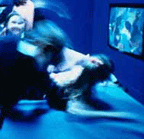
Touch at the Speed of Light
Telematic Dreaming [1992, Paul Sylvester Sermon], with its connotations of intimacy and dream states, extends telepresence beyond the screen to spatialize the site of interaction and transform it into a live theatrical event in which visitors are key performers. The work explores presence, absence and the psychology of human interaction within technologically mediated communications. Read an essay by Paul Sermon; more telematic works by Paul Sermon.
From medienkunstnetz>
...Sermon uses video-conferencing to connect people in different places, which enables communication with mime and gestures and results in astonishing, almost intimate encounters. In Telematic Dreaming a bed is the medium for high-definition images; images of a partner who is perhaps thousands of kilometers away, in live and intimate proximity. The clear projection of another person, who is able to react almost in real time to the other's movements on the bed, is so surprisingly suggestive that to touch the image of the body that is projected onto the sheet becomes an intimate act. Sermon's declared aim was to expand the user's sense of touch: obviously it was not possible to actually touch the other virtual bedmate, but one experienced the suggestion of touching through rapid and vigorous or tender and reflective movements. Many users said that they found it a very contemplative experience; a sensory impression achieved synaesthetically where hand and eye fuse. This quality distinguishes both Telematic Dreaming and other works that Sermon produced in subsequent years.
Posted by jo at 05:11 PM | Comments (1)
August 17, 2004
Chiasma
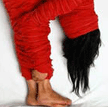
03 Biennial of Performance Art
Chiasma--a seventy-two hour, online performance art exchange--was a collaborative project between three international arts organizations: grunt gallery (Vancouver, Canada), Imperial Slacks (Sydney, Australia) and Folly (Lancaster, UK). Chiasma utilized live web streaming technology to investigate the potential of international exchange and collaboration through the web. Three artists--Rebecca Belmore, Lea Donnan, and Hester Reeve--were commissioned to create a piece of work specifically intended for live web cast. The performance was viewable virtually (as a screen on the web site) as well as remotely in six partner galleries spaces across the world.
Posted by jo at 05:10 PM | Comments (0)
networked performance discussion on empyre
From the introduction by Christina McPhee: "How does performative space become networked space? How might the traditions of theatre, dance and ritual, such as butoh, or 20th century avantgarde processes such as fluxus, inform or critique the practice and theory of performative, live movement? Is there a 'ghost in the machine', like a generative algorithm that sets in motion relations to live movement and virtual reaction? Where is meaning, and where is body? Is there a sense of place in performative networked space"? Continue reading on empyre
Posted by jo at 03:55 PM | Comments (0)
WiFi.ArtCache
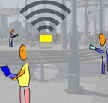
Local Networked Clouds
"The design challenge of this project is to create an apparatus that brings together physical proximity, narrative, interactivity and physical space in such a way as to engage a discourse about ubiquitous computing and the production of space."
WiFi.ArtCache reveals the leaky, spongy abutment joining our data and our physical world by tracing out the contours of networks. Through the limited range of WiFi systems, the Caches 802.11 radio creates a spatially constrained range of influence. Rather than relying on 802.11 WiFi technology to extend the reach of the Internet into physical space, WiFi.ArtCache uses 802.11 in a reverse mode of operation it relies on its limited range to create a small, local network cloud. See other Julian Bleecker projects at techkwondo
Posted by jo at 03:00 PM | Comments (0)
Autonomous Radiobodies
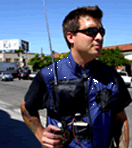
radiophonic graffiti
Autonomous Radiobodies is a public art performance/installation that involves people wearing or carrying units equipped with a Radio Graffiti Device for creating localized radiophonic art/graffiti spaces. As the technology of traditional radio hangs on the edge of artistic obsolescence and state-financed broadcasters use the medium to construct and enforce a national voice, newer mobile technologies are springing up and grabbing the public attention for commercial communication and artistic expression. This technological hype for the new presents an opportunity to exploit and reinvestigate the older wireless medium of radio and it’s renewed use as an art-space. Read more>>
Posted by jo at 02:45 PM | Comments (0)
more on mobile culture
Yo, kidda, nuOK
For anyone interested in the effects of mobile telephones on social and individual life, see Dr. Sadie Plant's 87 page work, on the mobile. In its conclusion Dr. Plant speaks of the use of numbers -- In Mandarin '521' means ' I love you' -- and how "when people from different linguistic backgrounds (non-English speakers) communicate by way of text, the search for the most dense and efficient texts often results in novel combinations of borrowed words and modified codes. Birmingham’s (England) Pakistani teenagers send messages using fusions of Caribbean, Punjabi, and SMS slang: Yo, kidda, nuOK? "Such mixed messages, “ Plant goes on to say, "are likely to become more common as texting spreads, and may even point to the emergence of localized hybrid languages: new textperantos for the mobile age.”
For an earlier post on Japanese use of mobile phones.
Posted by newradio at 10:55 AM | Comments (0)
dennis crowley

networks, mobile play & big brother
In the press a lot lately, are the works of dennis crowley, focused on 'finding the intersection between location-based services, social software and user-generated content on mobile devices.' His work includes dodgeball.com, a live, mobile-based friend finder, Pac Manhattan, where physical players do the PacMan thing around Washington Square Park, and Big Brother Foosball, a foosball game that displays your SS number while you play. [Posted by Nathaniel Stern]
Posted by at 05:41 AM | Comments (0)
August 16, 2004
mobile games
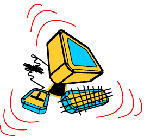
Mobile Hunt
-- the "ultimate scavenger hunt game engine"
Undercover
-- "The World is a Mess. GET TO WORK. Terrorism has become a critical and largely unknown enemy. Lunatics are making the world an unsafe place. It's past the time to stop it. This is our mission and, if you join us, your duty."
Two in a list of Location-Based Mobile Games found by Mjriam Struppeck from www.interactionfield.de
Posted by newradio at 11:35 AM | Comments (0)
August 15, 2004
Umbrellas in the Net
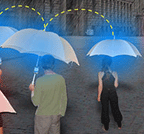
Spontaneous Wireless Mesh Networks
Gizmodo reports on Bluetooth Umbrella Networks: A team called "Umbrella.net" (no relation to Umbrella Corp, we hope) has developed a prototype system of Bluetooth umbrellas that facilitate "sudden, striking, and unexpected connections between people in public and urban space" by forming ad-hoc mesh networks when unfurled. As each umbrella is opened and added to the network, it lights as it comes online.
reblogged from Smart Mobs; posted by Paul Hartzog. August 13, 2004 at 09:46 AM
And Unstrung adds in Umbrellas in the Mesh:
In other words, create spontaneous wireless mesh networks that form when people put their umbrellas up -- and end when the rain stops.
This kind of mesh technology allows the devices themselves to act as nodes, passing data back and forth in an ad hoc setup, without a fixed connection to the wired Internet -- unlike the majority of commercial mesh products available.
The UMBRELLA.net project itself says:
UMBRELLA.net is a project exploring transitory or ad-hoc networks and their potential for causing sudden, striking, and unexpected connections between people in public and urban space. The project focuses on the theme of "coincidence of need", or how shared, yet disconnected activities can be harnessed into collective experiences. UMBRELLA.net examines how the haphazard and unpredictable patterns of weather and crowd formation can act as an impetus to examine coincidence of need networks. In particular, when umbrellas are opened and closed in public space. The project will attempt to highlight these informal relationships by creating a system of ad-hoc network nodes that can spontaneously form and dissipate based on weather conditions.
Now we finally know what those lighted umbrellas in Ridley Scott's film Blade Runner are.
Posted by jo at 01:05 PM | Comments (1)
carnivore clients

what lies beneath (the net)
'Carnivore is a controversial program developed by the U.S. Federal Bureau of Investigation (FBI) to give the agency access to the online/e-mail activities of suspected criminals' (from how stuff works. more info)
Rhizome's CarnivorePE, inspired by the original, allows artists to use all Internet traffic (email, web surfing, etc.) on a specific local network for their projects.
The free, downloadable software has been used to make visual, aural and physical computing projects that respond to, or dialogue with, the network, by some of the most prolific digital artists, including Jonah Brucker-Cohen, Golan Levin and Lisa Jevbratt (for more works and links, see the CarnivorePE page on rhizome). What else can we perform?
Posted by at 11:16 AM | Comments (0)
August 14, 2004
Topological Media Lab
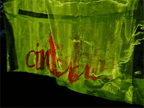
Responsive Media/Expressive Instruments
The Topological Media Lab provides a locus for studying gesture and materials from phenomenological, social and computational perspectives. TML research invents responsive media and expressive instruments that support novel technologies of performance and the architecture of hybrid media spaces. The products of the laboratory are (1) scholarly presentations, (2) media artifacts and performances as pieces of cultural experiment, (3) opportunities for students of design to sharpen critical faculties in project-based work.
Current application domains include: realtime video and sound synthesis, sensors, physical computing, computer-mediated human interaction, media choreography, active fabric and wearable architecture. Topological media is physical and computational matter, image or sound fashioned as substances evolving under continuous action.
The TML draws insights from studies of embodiment and materiality, performance and music, as well as dynamical systems and differential geometry and topology. Its projects also serve as case studies in the construction of fresh modes of cultural knowledge and techno-scientific practice.
Posted by jo at 06:34 PM | Comments (0)
In this interesting moment
From: Autonomous Zone: The Work-as-Art of Yury Gitman by Douglas Rushkoff, Wed Aug 11 09:00:00 GMT 2004
"...There is this interesting moment with emerging technology where it's malleable, where there is still room for play. It's a moment when our imaginations sprouts wings and our actions and choices can have lasting effects. We are in this malleable period in regards to Wi-Fi and mobile technology. Individuals, small research labs, university students and wireless community organizations can all still have an effect on the formation and development of wireless Internet networks and applications. They can have an effect on something that will solidify soon and possibly start redefining our lifestyles -- that's fairly exhilarating. That's the "high" early adopters pay for. That's the high that keeps community wireless organizations pulsing."-- Yury Gitman
Posted by newradio at 11:58 AM | Comments (0)
Wireless Phones in Japan

Ketai
Life with Ketai: the Culture of the Japanese "Almighty" Wireless Phone (Ketai)--Nearly 70% of Japanese use wireless, and more than 70% of these phones come with a camera. The Internet, video, TV, GPS, avigation system, avatar chat, games, karaoke... almost any service available on the Internet and all sorts of features related to visual entertainment have moved onto Ketai. Ketai is not just a mobile form of telephone but it is a new form of culture. Ketai cameras have changed people’s way of dealing with here-and-now.
Read Jason Seegert on the history and adoption of ketai in Japan -- and how Japanese use differs from American. Also check Wired Magazine for the hottest private eye in Japan and how she fights crime with her cell phone.
Posted by newradio at 11:39 AM | Comments (0)
FurtherStudio
real-time, online digital/net art residencies
furtherfield's furtherstudio is a unique artist residency, where our hero (the artist) is being watched, online in real-time, by viewers, critics, and other artists alike. Said viewers can respond to, critique, evaluate, discuss, and even collaborate with the artist-in-residence, whose completed, and in-progress, work is always available, and in flux.
So far, artists include Jess Loseby, Rich White, and now, replic**t. Admittedly, the visitor's studio is a bit confusing, but my guess is that this may be from a combination of a lot of use and uploading, and South African bandwidth issues...
Posted by at 11:05 AM | Comments (0)
August 13, 2004
front - I know you wanna

who is rubber and who is glue?
front, by Ralph Borland (South Africa), Jessica Findley and Margot Jacobs (both USA), consists of two performance suits, each with 'offensive' and 'defensive' inflatable air sacs. After suiting up over their own clothes, the two participants have a bit of a screaming match. Hidden microphones pick up the amplitude of their screams, and the battle begins. The suit of the performer who is louder (at any given time) will have offensive parts (like horns) that inflate, and defensive parts (like a constrictive neckpiece) that deflate - his or her opponent's suit will do the reverse.
Aside from the obvious performative strength behind sheer volume, and the animal-like battles that often arise from front, I can't help but wonder how this might work on a large scale. Who is to say these suits can't speak over a longer distanced network; what, where or who else could we effect? Where can I get a pair of these for my next poetry slam? Talk about blowing up in an argument....(Posted by Nathaniel Stern)
Posted by at 08:34 AM | Comments (0)
August 12, 2004
SimpleTEXT
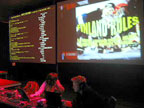
zeitgeist performing
SimpleTEXT is a collaborative audio/visual public performance that relies on audience participation through input from mobile devices such as phones, PDAs or laptops' (from simpletext website). This installation, created by mixing and matching older software projects by Jonah Brucker-Cohen, Tim Redfern and Duncan Murphy, accepts real-time SMSs and text messaging in order to create live music and visuals. The software first parses the text, which dictates the music, then uses these messages to rhythmically drive speech and picture synthesizers (direct from the web using google's image search). Although I've never seen it, my guess is that the most interesting part of this performance would be seeing a dialogue emerge between the piece, the performers, the audience SMSing in the space, and the audience texting from the web. A zeitgesit of ASCII that reiterates.... iterate.... iterative.... (ad nauseum) (Posted by Nathaniel Stern)
Posted by at 02:57 AM | Comments (0)
August 11, 2004
a mobile phone reporting tool
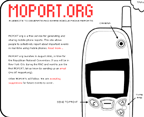
Moport
It's a new mobile phone reporting tool that Brooke Singer and Jamie Schulte of The SWIPE Toolkit fame will be launching in time for the Republican National Convention. If you'll be in NYC for the RNC, please consider joining the first ever Moport (a.k.a. MObile phone rePORT). 15,000 media representatives will be in attendance, but Singer and Schulte don't think they can necessarily handle the job--especially with 250,000 protesters expected to join the fun. If you are unable to participate, stay tuned and watch the RNC Moport unfold online starting August 30th. And, most importantly, help spread the word and recruit Moporters! For this first run, they're taking a "more the merrier" approach (or merry until their server comes to a screeching halt...).
About MOPORT.org:
MOPORT.org is a free service for generating and sharing mobile phone reports. This site allows people to collectively report about important events in real-time using mobile phones.
Features of a MOPORT:
• Enables Group Reporting using Cellphone Cameras or Digital Cameras and Email
• Instantly Updates when New Submissions Arrive
• Integrates News Feeds from Major Media Sources for a Quick Comparison of Event Coverage
• Sorts Images by Keywords that are Pre-defined and Dynamically Creates New Keywords Based on MOPORTER Submissions
• Sorts Images by MOPORTERS (Identities are Anonymous) for Individual Perspective and Commentary
• Accepts Submissions and Updates for Duration of Event and Later Archived on MOPORT.org for Viewing Purposes Only
How do I join: http://www.moport.org/f_equipment.html
What equipment do I need: http://www.moport.org/f_equipment.html
Why did you build this: http://www.moport.org/about.html
Demo of a Moport in progress: coming soon to http://www.moport.org/active.html
Posted by newradio at 10:12 AM | Comments (0)
A platform for collaborative performance
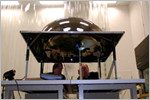
"The Pavilion: Into the 21st Century -- A Laboratory for Social Experimentation"
by Randall Packer, PlaNetwork Journal
"Inspired by Billy Klüver's 1970 art and technology masterpiece, the Pepsi Pavilion, artist/theorist Randall Packer is creating a NASA-supported digital, interactive artwork that will also be a platform for collaborative performances." The project " responds to Klüver's idea of freeing the spectator to make his or her own connections in the experience of the artwork.
"Pavilion: Into The 21st Century" will provide a platform for creation, a programmable, interactive 'multimedia performance instrument,' a laboratory and showcase for media experimentation. This multimedia 'instrument' will offer a critical forum for researching and advancing the integration of art, music and science into singular, multi-disciplinary artworks. It will also allow for the consideration of the social implications of emerging forms of interactivity in networked environments."
For more information
With thanks to Ken Jordan
Posted by newradio at 08:51 AM | Comments (0)
performatives
speech acts and difference
In the early sixties, JL Austin coined the term performative - calling it an explicit utterance - which differs greatly (and seemingly magically) from the descriptive constative. While the latter explains, the former - often called a speech act - actually makes an ontological change. 'I now pronounce you man and wife,' 'I apologize' and 'Go, you fool!' (a command) are all actions, as well as words (whoa. 'actions speak louder than words' is now a void concept more info). In the present, many interventionist artists have taken on this term, and performative has come to mean virtually any expression, gesture or performance that transforms or births identity, ideology, history (and the list goes on...). So, beyond networked_performance, what would constitute a networked performative? What happens when we (click) submit? When we reset our form? Aside from a node, what can we create? And beyond making a difference, how different can we be? If Salvador Dali performed surrealism, what is it we are performing into or out of existence? (Posted on Nathaniel Stern)
Posted by at 04:27 AM | Comments (0)
Flash Mobs --the first, second and historical precedents
FLASH MOBS
"The idea was that the audience would become the performance"
The first Flash Mob, according to Bill, it's anonymous planner, was to take place at Claire's Accessories near Astor Place in New York City. Claire’s sold hair scrunchies and barrettes and was the kind of store where you seldom saw more than two or three customers at a time. The idea, Bill said, was "that people would arrive, fill the entire store, and that those trapped outside would start chanting "Accessories!"" But when the crowd arrived, Claire’s Accessories was already swarming with cops.
On Tuesday June 19, 2003, at precisely 7:27p.m. the second Mob gathering took place and with great success as 150 people gathered in Macy’s midtown store and surrounded a $10,000 Persian-style carpet. Explaining that they all lived together in a communal style warehouse in Long Island City and were in the market for a Love Rug, the Mob hovered around the carpet until exactly 7:37, and then left – without the rug.
"Flash Mobs were an experiment," Bill said, "in using email to bring strangers together in a collective action directed towrd simple politics. In these specific cases, people choosing fun."
Read more about the early history of Flash Mobs and their historical precedents in My Name is Bill… by Alec Hanley Bemis in the LA Weekly, August 6-12, 2004.
And while you’re there, check out Judith Lewis’ The Future Belongs to Crowds: a brief history of spontaneous gatherings.
Posted by newradio at 03:35 AM | Comments (0)
August 10, 2004
Silent Cell Network
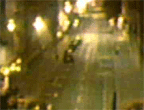
Silent Dystopia
After taking part at the International MICRO performance in Ljubljana/Slovenia, Silent Cell Network performs live again: August 11, 2004, 1:30 AM, GMT+1 (Paris/Berlin time); performed at an unknown location and broadcast live on the net. Silent Cell Network is an international group of multimedia artists, this time joined by Hooman Sharifi. Sharifi is an established Iranian performer, dancer and choreographer, living and working mostly in Norway and Belgium.
Posted by jo at 08:46 PM | Comments (0)
mobile hawker
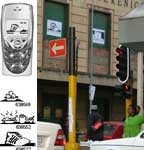
mobile hawker
If you are unfamiliar with South African slang, you won't know that a hawker is a street seller - one who might approach your car, or have a table on the side of the road.
With South Africa's high unemployment rate, and pay-as-you-go mobile phone non-contracts, both hawkers and ring tones have become completely pervasive on the streets.
marcus neustetter brings these two cultures together, by selling his cell phone art (geared for the cheapest model mobile in SA) for the cost of an SMS. Similar to the physical hawkers, he has also taken to the streets with his goods; shown here are ads for his immediate access art in downtown Johannesburg. These pics are not only regularly downloaded, but often fowarded to friends, and used as the background image on main screens.
Posted by at 05:11 AM | Comments (0)
August 09, 2004
report from SIGGRAPH
![]()
transverging in LA
I'm at SIGGRAPH this week checking out the scene - most notably, emerging and interactive technologies. Of interest yesterday, Sunday, were Artist Round Table sessions. In the session Researching the Future the panelists discussed their work in relation to creating new models that reflect epistemological changes resulting from current scientific and technological development.
The session led off with the Planetary Collegium model as a general framework for approaching the art + science collaboration.
While all quite compelling, the resonance for this blog (and applicable to all practice) came from Marcos Novak's presentation on 'transvergence'. This excerpt from Marcos' site summarizes the changes necessitating a transvergent approach to research and practice:
In short, we conceive algorithmically (morphogenesis); we model numerically (rapid prototyping); we build robotically (new tectonics); we inhabit interactively (intelligent space); we telecommunicate instantly (pantopicon); we are informed immersively (liquid architectures); we socialise nonlocally (nonlocal public domain); we evert virtuality (transarchitectures). He has also posited a new "Soft Babylon," a theoretical stance which posits that our digitized architectural palette is causing us to create a wired Situationist city, while we struggle with some of the massive paradigm shifts that our era will and must face.
Novak explains: “transvergence, in a pedagogical and research context, refers to the study and applications of concepts and methods by which convergence of disciplines, media and technologies is seen not as a goal in itself, not as the focal point of a predictable origin for divergences but as an opportunity to speculate and propose novel transdisciplinary epistemological and creative formations. Using willful strategies of derailment, it seeks to promote the mergence of previously unattainable but presently potentially viable species of efforts: future genres, future fields of inquiry, future arts, media and sciences”.
I wonder what a practice of willful deraillment would be when applied to networked performance and who is formally investigating this.
In another session, Ars Electronica: 25 Years of the Digital Avant-Garde, Michael Naimark discussed interactive art conventions. As an Ars juror reviewing vastly differing interactive works, he notes these problematic points that need to yet be addressed:
• difference between the content and the tool
ie - when projects have vastly different use of content and tool, the criteria was to favor the work that best subverted expectations.• actual versus apparent interactivity
ie - the clarity or ambiguity of interface responsiveness - most problematic in performances in which an audience is observing a performer - how does the audience know when the performer has interacted with the work?• does the user feel in control via the interface or not?
ie - such as with obvious versus metaphoric interaction and cases when using input and interaction as a 'not directly representational' form (as in the case of interaction controlled or effected by data collected by means other than direct navigational control.)
I'd also recommend folks cruise through the Ars archives for a 25 year chronicle of digital media art presented at Ars.
Posted by michelle at 10:36 PM | Comments (0)
MYRIORAMA
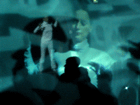
responsive performance space
ambientTV.NET and kondition pluriel invite you to MYRIORAMA a locative media dance performance. In London: August 12 & 13 2004, 21:30h at Project Market, Silwex House, Quaker St., E1 6SN; in Helsinki: August 21, 2004 14:00h at Kiasma Theatre as part of ISEA2004 festival. Myriorama explores position- and motion-tracking at widely different scales: across the city, and inside the venue. The wanderer’s location in the city is reported by satellite-based Global Positioning System (GPS), and fed into the venue’s local network via a cellphone network (GPRS) and the internet. Inside, the data are manipulated and transformed in real time by the dancer's gestures, using a wireless sensor system. The emergence of cellphones, GPS, and other location-aware devices seems to favour the local and contextual over the global. However, most of the communication networks that these devices operate in remain centralised and closed.
Once upon a time, in the kingdom of Myriorama, there ruled a king who knew the art of reading and bending the thoughts of his people over great distances, which rendered him famously powerful. One day, a wanderer entered the kingdom...Taking a hint from Italo Calvino's story 'A King Listens', Myriorama unfolds the world of one whose environment is all ears and all eyes; one for whom every whisper and rumour is heard distinctly, for whom every movement is watched and logged. Today, equipment designed for a paranoid king has become the plaything of the people, part of our everyday gadgetry and woven in the fabric of the city.
For this production, ambientTV.NET and kondition pluriel have repurposed location-aware mobile devices, motion sensors and audio-visual transmissions to fashion a responsive performance space that both extends beyond, and is concentrated in the venue itself. The protagonist at the centre of Myriorama tracks his subjects, agents and avatars as they move through the city. The one in the place of the king watches, commands and interprets a mediated world, a domain of data, a screen of projected subjectivities in which inside and outside are entwined.
Posted by jo at 12:59 PM | Comments (0)
the polite force
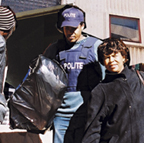
polite force
Christian Nerf's polite force project began as a subversive public performance, speaking back to the legacy politics always already in play in the 'New South Africa.' He took riot gear uniforms (complete with shields and helmets) from during the Apartheid era, and modified them to read 'polite,' rather than 'police,' asking his actors to carry bags, help people cross the street, light cigarettes, and compliment the outfits and hairdos of onlookers. The project began on September 11, 2002, also speaking directly to the politics of the post-9/11 world, and therefore garnering interest beyond South African borders. Through word of mouth, email, and his (admittedly, largely outdated) website, he's had invitational polite performances (by friends and strangers alike) all over South Africa, in New York City, Trinidad, Washington DC, and (soon to be) Boston. There are now several editions of varying polite uniforms, including his new project, the metro polite (shown, in bullet-proof vests and peak-caps), that come with guidelines and potential training sessions (though some galleries insist on waiver forms for their wo/men in uniform). You can ask to borrow, print or obtain a polite force uniform through Mr. Nerf, at the site linked above. (Posted by Nathaniel Stern)
Posted by at 12:29 PM | Comments (0)
Kunstradio //\ art@radio
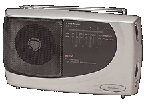
jamming radiophonic space
art@radio is pleased to present "jamming radiophonic space," an international on air- on line- on site event September 3rd from the studios of the University of Maryland, Baltimore County in participation with the project RE-INVENTING RADIO a Co-production of Ars Electronica Festival and Ö1 Kunstradio. "We are interested having artists phone in environmental sounds via cell phone during the event. These sounds should deal with notions of connectivity and the current environment in which call originates. If you are interested in contributing to the cell phone part of the event please e-mail projects@joereinsel.org."
"jamming radiophonic space," modulates the interplay of radio, Internet, wireless transmission, and mobile phone signals from public and private space. Live stream: 13:30-00:00 Baltimore, Maryland [GMT "time converted"]
Artists: Goeff Bell, Steve Bradley, Phaye Poliakoff-Chen, Chad Eby, John Hopkins, Brendan Howell, John Hudak, Jacob Kirkegaard, Tim Nohe, Joe Reinsel, Jodi Rose, Bill Shewbridge, Nicole Shiflet, and John Sturgeon
This experientially diverse and geographically scattered group will contribute to "jamming radiophonic space" through decentralized, networked and collaborative strategies of production and distribution. Streaming feeds from microphones placed in and around artists' workspaces will be gathered along with ambient sound called in via wireless and landline phones; requests have already gone out over electronic list-serves for individuals to call in and point their live phones for 10 or 15 minutes toward sounds emblematic of their time and place.
These sonic interruptions will then be mixed and processed into a stream of "hot media" by artists present in the Baltimore studio space using baby monitors, short-wave radios, software and other improvised sound tools. The stream will then be made available worldwide to streaming clients via wired and wireless data connections.
For more information and a detailed schedule refer to http://art-radio.net/kunstradio/
Posted by jo at 12:16 PM | Comments (0)
More on Categorization
Helen Varley Jamieson
On Cyberformance
there are lots of different terms & definitions & many of them are
problematic for all sorts of reasons. that's why i made up the term
'cyberformance' in 2000 & have been using that since then to describe
what i do. my definition of cyberformance is the use of the internet
to bring remote performers together in real time for live
theatrical/performance events. this includes both purely online
performances, where the audience must also be online, performances
for a proximal audience who are together in a physical space where
the performance takes place, or a mix of both. the essential thing is
that the performers are coming together via the internet.
to me, "avatar performance" would mean that the performers are
represented by avatars, much like puppet theatre. so the
cyberformance work that i & avatar body collision has been making
includes avatar performance, but it's not limited to that - we also
use web cams & live performance (we talk about this as being multiple
stages, & layers of re/presentation). "avatar performance" wouldn't
necessarily have to involve the internet - i know of some people in
belgrade who are developing what they call "avatar theatre" & at the
moment it exists as a navigable cd-rom with avatar characters; they
plan to give a live performance using a LAN in a gaming centre - so
that would be avatar performance without being on the internet.
then there is the term "networked performance" - which i guess
includes cyberformance but also other forms of networked performance
that don't involve the internet.
Posted by newradio at 11:27 AM | Comments (0)
Séa.nce
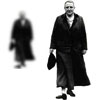
A Sea of Emotions
You are invited to Séa.nce, a networked performance that is part of ISEA2004. Séa.nce--a collaboration between Norie Neumark, Maria Miranda and Greg Turner--is a 'pataphysical' experiment to demonstrate the relays of perpetual emotion on the Internet. Séa.nce will be particularly helpful for those of you who are feeling at sea with your networked emotions.
Please bring your own data. For those on board the ISEA ferry please bring your own laptop. Be there: August 15, midnight–1:00am GMT+2; August 16, 22:00-23:00pm GMT+2 [GMT+2 is Helsinki time]. Bring all that pentup listAngst, emailObsessiveness and spamRage. The Board is here to help.
In the 19th century Etienne-Jules Marey, Henri Bergson, Arsène d'Arsonoval and Marie Curie met to investigate "the manifestations of yet undefined forces" through scientific investigations using Marey's graphing instruments. These investigations attempted to measure radioactivity and electric discharge of hysterics; to study telepathy and levitation; and to hold Seances.
Séa.nce, following these earlier experiments, is based on this popular parlour game from the 19th century. The original Ouija Board was also known as the Talking Board or the Message Board where one would search for answers from the spirit world. The modern equivalent of this 'searching for answers' could be imagined as Google or any search engine for that matter. Are there 'unknown forces' still at play? What happens when answers depend on a network of movement? Read more.
Séa.nce is part of a larger project, The Perpetual Emotion Project, which researches emotion in digital culture. The Perpetual Emotion Project and several other Miranda/Neumark works are at turbulence.org.
Séa.nce was assisted by the Australia Council, the Federal Government's arts funding and advisory body.
Posted by jo at 09:56 AM | Comments (0)
Guest Blogger
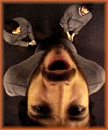
Welcome nathaniel!
Our first Guest Blogger, nathaniel stern, is a New York artist currently residing in Johannesburg, South Africa (if you're interested in the South African art scene, his own blog is a must!). He will periodically make posts on behalf of other South Africans interested in the developing field of networked performance.
nathaniel is an internationally exhibited installation artist, net.artist and performance poet. His collaborative physical theatre and multimedia performance work has won three FNB Vita Awards - including Best Presentation of a New Contemporary Work - and has been featured on the main stage at the Grahamstown Festival (South Africa). His poetry repertoire includes the US National Poetry Slam competition and the HIV/AIDS Arts, Media & Film Festival (South Africa). nathaniel's interactive installations have also won awards in New York, and Australia, and his net.art has been featured in festivals all over Europe, Asia and the US.
nathaniel received his BS in Textiles and Apparel Design from Cornell University, and his Masters from Tisch School of the Arts, NYU, in Interactive Telecommunications. He currently works both in and from Johannesburg, as an adjunct (distance teaching) faculty member of the Minneapolis College of Art & Design, external lecturer and supervisor at the Wits School of Arts' Digital Arts MA, and freelance lecturer at Newtown's Anti-Retroviral Theatre program and The South African School Of Motion Picture Medium and Live Performance.
Posted by jo at 09:53 AM | Comments (0)
August 08, 2004
Eurodans
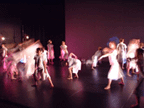
Collaborative Choreography
Eurodans was a choreography project on the Internet. It linked dance students from selected higher education institutes across Europe. This project was a partnership between University of Leeds and ULTRALAB, working with European League of Institutes of the Arts Dance Section. The dance students worked in their own institutions across Europe, collaborating via the Internet. They used the Snugfit software to build Web pages within a password-protected site. These pages were records of the dancers' rehearsals using movies, images and text. Two choreo-coordinators ensured that a single dance was created between all the groups. Read a paper about this process.
Posted by jo at 05:36 PM
Noderunner

Racing Against Time
Noderunner--by Yury Gitman, Carlos J. Gomez de Llarena--is "a competitive game (that) fuses the streets with wireless networks to convert the city into a playing board. Two teams racing against time must log into as many modes as they can and upload photographic proof to the server, documeting their progess." Noderunner won the Golden Nica for Net Vision/Net Excellence at Prix Ars 2003. Read more
Posted by jo at 04:02 PM | Comments (0)
Never say No
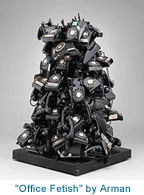
Phoneyvents
"There is No telephone Art," Gregory Battock proclaimed in New Artists Video, A Critical Anthology in 1978. But:
Have you ever heard of "phoneyvents"? Jim Pallas began work on them in 1973. They were originally audio works played to recipients in a telephone number book. Based on the idea that a "telephone bell elicits a state of focused attention in most Americans," and that most are ready for communication "whose content could be anything," Pallas' work invoked surprise and a sense of intrusion in those answering his calls.
"The Phoneyvent," he writes, "would be cued up on an audio cassette tape player. The player was patched into the phone line. DC voltage isolation was obtained by using a 50 mfd capacitor in series. I dialed the recipient's number and when they answered, I played the event while listening in."
Pallas went on, in 1978, to develop the less intrusive "dialevent," which consisted of a number you could call to get a "phoneyvent" played over an automatic telephone answering machine.
Phoneyvents became so popular after an article in the Detroit Free Press, that the Bell Telephone Company sent out an inspector to investigate why the trunk lines were overwhelmed with traffic. You can listen to a selection of original 1978-79 events at http://www.jpallas.com/phone/dialyvent.html
Posted by newradio at 12:10 PM | Comments (0)
August 05, 2004
On Categorization (herein)
Networked Performance Categories
For those of you who read Sara Diamond’s “Hello, Hello! A short history of networked performance art” in issue 13 of HorizonZero, Bruce Barber's definition of performance will be familiar. It’s inclusive, perhaps some will think too inclusive.
Barber "proposes performance as an engaged and committed task of acting on culture. ‘The task’ he says ‘ becomes restorative and critical’. "
As we struggle to set up categories for the works included on this blog, (hoping to make it easier for people to find works that interest them), we find ourselves struggling without much conviction. Networked performance--an area where borders are porous, dividing lines broken or to be broken, and territories redrawn or to be redrawn. All in process. Why categories then?
In this state of ongoing transformations, Barber’s proposal is welcome.
The categories on this blog evolved from the following thoughts -- to create categories that reflect:
1) how artists label their own work
2) a continuum with existing labels and practice
3) an intent to focus on the space in-between established practice.
With the latter, this also determined that entries would be catalogued in one or more applicable categories.
Now that a volume of content is amassing , the questions becomes one of utility. Are the intentions of the structural methodology overrun by the manifestation of similarities between categories and made confusing and/or meaningless? Or conversely, does the multiplicity of cataloguing enrich the cross-listing/cross-referencing?
We would like your response.
Posted by newradio at 08:40 PM | Comments (0)
Whitman's phones

Cellphone Performance
11 October 2002, Leeds, UK: (Evolution 2002: PROCESS) During his first visit to the UK, seminal American artist Robert Whitman produced a 30 minute cellphone performance based on a 1960's work he originally performed using payphones in New York City.
The performance in Leeds used 30 volunteers with cellphones stationed at pre-defined locations around the city centre. The volunteers repeatedly called a central telephone number and switch board situated in Millennium Square and, when their call was answered, gave a short description of their location. The resulting calls were mixed by Robert and relayed live through public address speakers to an audience in the outdoor square. The performance painted an aural description of the city at that given time.
During the 1960's Whitman distinguished himself with sophisticated theatrical works involving interaction between live performers and filmed images. For more information on this little-known artist, who along with with scientists Fred Waldhauer and Billy Klüver and artist Robert Rauschenberg, cofounded in 1966 Experiments in Art and Technology (E.A.T.), a loose-knit association that organized collaborations between artists and scientists, see Robert Whitman’s Telecommunication Projects by Bettina Funcke. As Funcke writes, "The little-known work of Robert Whitman...deserves serious reconsideration, partly because it can be seen as an unconscious prehistory to much of today’s art."
Posted by newradio at 08:29 PM | Comments (0)
ambienteTV.net
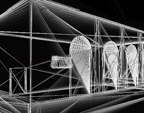
Telematic Traces
ambientTVnet is a crucible for independent, interdisciplinary practice ranging from installation and performance, through documentary, dance, and gastronomy, to sound and video composition and real-time manipulation. We continue to develop social and technical infrastructure and promote network architectures that facilitate alternatives to current socio-political and economic formations. Techniques and effects of live data broadcasting and transmission provide theme, medium, and performative space for many of the works.
Networked Performance: The performance incorporates geographically distant real spaces into the theatre space. The narrative grows out of telematic feedback, and the interplay between real spaces and imaginary realms. Daily life’s occupation--Streetwalking, food preparation or conversing – are presented as a narrative act. Rehearsal, orchestration, choreography, improvisation, the unpredictable response of the audience and traces of city walks are brought together by the crossing of data streams that technology allows. Stories and characters are built through fragmentary vignettes and scetches, and the streaming might be seen to figure how we weave stories and sense from our daily move-abouts and their chaos of traces; traces from which we project a transcendent geography of the self. The theme and structure of the pieces are woven together by crisscrossing of telematic links between a performer in a venue, and a roaming performer in the neighbourhood.
AV DINNERS: EPIC EROS live and online audio-visual gastronomic event. The first in a series of sensory networked cook-ins featuring collaborations between digital and performance artists and chefs.
TELEJAM: TRYPTICHON audio-visual jam session between a venue and its neighbourhood. Roaming performers equipped with location-aware devices write their movements on the urban canvas (London Nov. 2003). Read a review of their April 4, 2004 performance.
MYRIORAMA telematic theatre/dance performance featuring NYC motion poet Ajay Naidu (2004)
Posted by jo at 08:26 PM
n0media

Decentred Improv
decentred | distributed improvisation, an experimental performance space programmed by Tom Simmons & Liam Wells of n0media, took place between 15th March & 17th April 2004. Decentred connected Norwich Gallery with a variety of remote locations & creative partners. A community of visual, sonic, media and performance artists worked within a specially created network in a series of online collaborations, webcast live from this URL.
Posted by jo at 07:03 PM | Comments (0)
wannaboogie.com

Staccato Movements
wannaboogie.com is the outcome of endeavours to create innovative dance that, unlike conventional dance, is viewed on the internet rather than on the stage, cinema or television screen. It is both a performance piece, which can be streamed over the web, and an interactive choreography piece enabling the viewer to interact with the choreography and create their own dance piece to accompanying music. (more)
Posted by jo at 06:53 PM | Comments (0)
Mobile Phone Performances, Installations and Artworks
Golan Levin's Informal Catalogue
"In the summer of 2001, while my colleagues and I were preparing the Dialtones mobile phone concert, I began to hear rumors and news items that other people were planning similar events. Given the astonishing growth of mobile telephony, one could hardly be surprised. Still, it's important to know the details of concurrent trends, and so I started collecting this list. Since that time, various folks (and in particular, Jonah Brucker-Cohen) have sent me information about other artworks that use mobile phones. Although I don't know if I'll ever do another mobile phone project, I also recognize that resources like this can be useful to other people who might. So if you know of something that should be listed, please email me (golan at flong dot com) and I'll gladly add it in. -- Golan"
Posted by jo at 06:37 PM | Comments (0)
cellular trans_actions 091101

Amplifying the Self
cellular trans_actions 091101, a cell phone performance by Victoria Vesna, was part of an exhibition called Avatars and Others. It took place on September 14, 2001. cellular trans_actions consisted of a series of works that looked at our relationship to time, the constant interruptions, and how the rupture of private and public spaces changes us. Cell phones are central to the interactions created in public spaces, amplifying issues related to our shifting perception of self...People were given numbers of others and through the mediation of the cell phone, talked to strangers that they would normally not have more than superficial conversations with. The performance was accompanied by site and time specific installation, recording the flavor of a particular geographic and social location. Read more.
Posted by jo at 06:09 PM | Comments (0)
Ballettikka RealVideo Internettikka
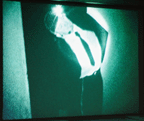
Tactical Ballet
Ballettikka RealVideo Internettikka is the third self-contained action in the tactical project Ballettikka Internettikka, which began in 2001 with the exploration of Internet ballet. The second installment, in March 2002, consisted of Stromajer and Zorman carrying out an illegal ballet invasion in Moscow’s Bolshoi Theater and transmitting it live on the Internet. In Part 3, Grassi, Stromajer and Zorman brought together two Moscow performative acts: the ballet break-in in the Bolshoi and the Chechen terrorist act in the Dubrovka Theater in October 2002. The condensed version of Ballettikka RealVideo Internettikka consists of a video with Morse-code dramaturgy. The net performace Ballettikka Internettikka: ilegallikka robottikka, by intima, will take place in November 2004. (more)
Posted by jo at 05:38 PM | Comments (1)
Radio Cycle

Sound Interference
Radio Cycle, produced by Kaffe Matthews and collaborators, is a live radio station that broadcasts your stories, news and favourite sounds directly onto the streets as teams of radio-carrying cyclists map out the East end. It was part of Interference: Public Sound which took place in the UK in 2003. The project brought together a series of sound art projects "that engage with communication and shared memory as well as reflecting the current crossover of art, technology and action."
"Growing out of a week of workshops in Bow, Radio Cycle's highlight was a series of pieces that were broadcast and ‘played’ by a group of cyclists carrying radios and following predetermined routes in the area. Citizens out and about in London Fields, Victoria Park and streets in the vicinity would encounter these mobile soundworks as they drifted by on wheels. The local streetmaps, Matthews explains, took on the character of scores for her.
"It suddenly dawned on me that the radio itself is like a mobile stage," she tells me. "Originally I wanted to have a mobile radio station but we couldn't do that because you're not allowed to have a licence and be mobile. Radio Cycle was about this invisible activity, this subtle alteration of what's going on around you. Which explains the bicycles. You'd be walking down the street and a bicycle goes by. You probably wouldn't notice the bicycle but you'd notice some sound. A piece of music floating by. Just subtle little tweaks, altering people's environment to turn them on to what they're hearing." Continue reading at Wire feature by Will Montgomery, September 2003.
Posted by jo at 05:00 PM | Comments (0)
Fun with Videophones

The Hookup
An original production by Kurt Bigenho, Harmon Leon, and Hal Phillips, The Hookup is a live, interactive reality spectacle using (or mis-using) the marvels of video phone technology. Two contestants will hop from bar to bar trying to score. The imagery will be sent back to the gallery via videophones and you, the audience, will decide what happens next! (more)
Posted by jo at 04:19 PM | Comments (0)
Help is on the way
TXTmob
A free service that lets you share text messages with friends and strangers. Designed for protesters at the Democratic National Convention in Boston, it's being/been revamped for use in New York at the Republican National Convention.
Posted by newradio at 01:32 PM | Comments (0)
Spectropolis: Mobile Media, Art and the City
New Urban Experience
Spectropolis: Mobile Media, Art and the City is a three-day event that highlights the diverse ways artists, technical innovators and activists are using communication technologies to generate new urban experience and public voice. The event explores what is possible when wireless communications (both new and old), mobile devices and media converge in public space. The increasing presence of mobile communication technologies is transforming the ways we live, construct and move through our built environment. The participants of the Spectropolis exhibition make obvious or play with this shift, creating new urban perceptions and social interactions with cell phones, laptops, wireless internet, PDAs and radio. In addition to the projects presented in the park, there will be several hands-on workshops and two panels free to the public. Find out more
Posted by jo at 12:41 PM | Comments (0)
In the New Nation, I want _____
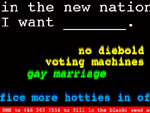
The Screensavers
At the NewNation Party in DUMBO Brooklyn, NY a few weeks ago, a collaborative group of NYC artists known as Screensavers produced a live SMS-interactive video projection. Their projection posed questions to the party guests as they lined up to enter the venue, such as "In the NewNation I want ____", or "I would ____ for _____ in the NewNation." At the bottom of the projected image was a call to fill in the blanks by sending a cell phone text message to a particular phone number. Submitted text messages would appear in the projection, and scroll as new messages were received. The projection lasted a few hours, and was located in front of the event in DUMBO where 100-200 people waited in line to enter the venue. There were approximately 2000 total attendees, and the projection steadily received an incoming stream of messages. (more)
Posted by newradio at 11:22 AM | Comments (0)
August 04, 2004
After the Crash

RICHAIR2030
RICHAIR2030 by TAKE2030 is a fictional wireless performance set in year 2030. RICHAIR2030 incorporates ideas of the freenetwork movement developed worldwide in the early 21st century and proposes shared public consumption of wireless bandwidth in an "After the Net", "After the Crash" scenario.
It is the year 2030. The great wireless hope that promises mobility and connectivity has bubbled. The GPS satellite signals have lost track of its urbanites when cutting through the Ozone layers. The ocean-apart digital divide has sabotaged the Net. What remains of the feeble bandwidth is held and safeguarded by the wireless freenetworkers, whose self-organized and decentralized network maintains its data cloud in local communal mesh-settings. The mobile generation is grounded. The tribal gathering around freenetwork nodes is the only game in town, bringing together the signal-seeking Desparati. The self-appointed renegade roller girls, acting as the Transmitenti of free bandwidth, travel city limits in auto-powered modules. Equipped with homemade lunchbox chiputers, the roller girls pump the remaining wireless signal strength in RGB codes and sonic extravaganzas. RICHAIR2030 mobilizes roaming nodes and calls for trans-national virtual mesh network.
RICHAIR2030 works with London freenetworkers and pays tribute to the world wide wireless freenetwork movement.
RICHAIR2030 team has developed 3 chiputer (compact computer with single chip motherboard) lunchboxes that draw parallels and refers to the techno DIY culture characteristic to the UK media scene at the turn of this century. The software system is based on free BSD, linux and mesh AP applications that allow automated reboots, wireless roaming, and data push at chosen locations. The interface programming further translates raw data into visual and sonic applications. In its compact lunchbox a 256 MB flashcard holds all the data.
RICHAIR2030 is developed by TAKE2030 brave new media society that sets up and manages multiple research+development+action media-working units. TAKE2030 designates its media practices in Commons societies and proposes its strategic programme development till year 2030. Take2030: Ilze Black, Alexie Blinov, Shu Lea Cheang, Chia-liang Kao, Paul Khera, Gio D'angelo in collaboration with East London community network and sonic artists: Supermoden and 1010.org.
RichAir2030 is currently touring the UK. Next performance: August 15, 2004, Bow Arts Festival, London
Posted by newradio at 12:16 PM | Comments (0)
August 03, 2004
Lag and Flux as Starting Point
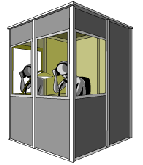
Simultaneous Translation
John Roach is working on a multilocation networked audio performance called Simultaneous Translation which will involve players from USA, Spain, France, Italy and Germany. The first performance is slated for November 2004 in Madrid Spain. Other manifestations are planned for NYC and Trondheim Norway.
"In my first foray into networked performance entitled Negative Space it was the limitations of the streaming media which made the project difficult and exciting. This lag and flux is the starting point of Simultaneous Translation in which the idea of flux and slippage is put in the forefront and is compared to the slippages and mutations of language as it evolves. Another point of comparison is to the delays that occur on the web as data passes from router hop to router hop. In fact traceroute data will be used to manipulate audio streams from the remote participants, making the delay of the internet itself an active player in the project."
Posted by jo at 05:03 PM | Comments (0)
Painting the Street
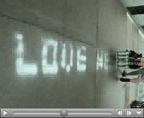
Bikes Against Bush
From "Bike Writer Pedals for Protests" by Leander Kahney, Wired News, August 2, 2004
New Yorker Joshua Kinberg is a bike messenger of a different stripe. Instead of ferrying legal papers between lawyers, he uses a homemade, wireless, bicycle-mounted dot-matrix printer to spray protest messages in the street...[Bikes Against Bush is] "painting on the street, but on the Net, too," said Kinberg, a post-graduate student at Parsons School of Design.
Continue reading at Wired.com
Posted by jo at 10:37 AM | Comments (1)
August 02, 2004
Mesh Performance Practices
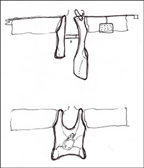
Exiles, Ghosts and Astronauts Physical interventions in the critique of virtual culture
Aura: Film Studies Journal, Volume IV, Issue 1, 1998, Susan Kozel
Exiles, Ghosts and Astronauts was a performance experiment occurring simultaneously between Riverside Studios and The Place Theatre in London (England). The videoconference link was made by Macintosh computers and basic internet videoconferencing software (CU-SeeMe). Performers in each location were projected into the other for a physical exploration of intimacy, weightlessness and altered materiality. It was part of Digital Dancing 1997, the London Dance Umbrella platform for dance and technology collaboration.
As physical exploration is undertaken, with telepresence and other forms of digital intervention in performance, the physical and philosophical vocabularies that emerge are mutually shaped and critical of one another. This article charts a course through philosophical debate and performance practice. Many voices and perspectives unfold across three sections: dialogue with Paul Virilio, devising process, and performance.
Continue reading at Mesh Performance Practices
whisper is a real-time interactive media installation based on small wearable devices, wireless computer communication, and handheld technologies embedded in evocative and playful garments worn by the participants. whisper intervenes aesthetically and critically in the evolution of our human environment by transforming the physical practices and technological interfaces that mediate our physical and emotional interchange. whisper is about creating new physical, technological, kinesthetic & affective vocabularies. whisper is a collaborative project involving artists (dance, sculpture, music), designers (of visuals, objects & textiles), computer scientists, and hardware/software engineers.
Posted by jo at 03:14 PM | Comments (0)
iSee Wireless

iSee Wireless
We are in the midst of two wireless revolutions, one defined by large corporations that buy spectrum, the other defined by ad hoc networks and open standards. We are focused on contributing to this second, more democratic revolution.
Julian Bleecker (Art Cache Machine, WiJacker, Proximity Wireless projects utilizing WiFi Toolkit software.) explores practical and playful uses of WiFi through a series of projects created with the WiFi Toolkit, a set of software APIs Bleecker developed as Engineer in Residence at Eyebeam. Art Cache Machine, the WiJacker and Proximity are three WiFi-enabled applications developed to investigate the possibilities of "partially connected" WiFi social networks using access points deliberately off the public internet. Art Cache Machine is a mobile WiFi node that provides an access point for specific digital art that can only exist within the locale of the Machine's WiFi node. WiJacker assumes the role of a WiFi node by hijacking the activity of users. Proximity is an ad-hoc communication service that enables connections between devices without user intervention.
iSee is a web-based application charting the locations of closed-circuit television (CCTV) surveillance cameras in urban environments. With iSee, users can find routes that avoid these cameras -
Who should use iSee
The past several years has seen a dramatic increase in CCTV surveillance of public space. Video cameras peer at us from the sides of buildings, from ATM machines, from traffic lights, capturing our every move for observation by police officers and private security guards that often act with very little public or legislative oversight. While the effectiveness of these devices in reducing crime is dubious at best (see below), recent cases of misuse by public and private authorities serve to question the appropriateness of video monitoring in public space. Here is a short list of people who might legitimately want to avoid having their picture taken by unseen observers:
Minorities
One of the big problems with video surveillance is the tendency of police officers and security guards to single out particular people to monitor. It is hardly surprising that the mentality leading to racial profiling in traffic stops has found similar expression in police officers focusing their cameras on people of color. Indeed, a recent study of video surveillance in the UK, the leading user of CCTV surveillance systems, says that "black people were between one-and-a-half and two-and-a-half times more likely to be surveilled than one would expect from their presence in the population." It is worth pointing out that, in this study, 40% of people that the police targeted were picked out "for no obvious reason," other than their ethnicity or apparent membership in various subcultural groups. In other words, they were singled out not for what they were doing, but simply based on how they looked.
Women
It appears that police monitors just can’t seem to keep it in their pants when it comes to video surveillance. In a Hull University study, 1 out of 10 women were targeted for “voyeuristic” reasons by male camera operators, and a Brooklyn police sergeant blew the whistle on several of her colleagues in 1998 for “taking pictures of civilian women in the area ... from breast shots to the backside."
Youth
Young men, particularly young black men, are routinely singled out by police operators for increased scrutiny. This is particularly true if they appear to belong to subcultural groups that authority figures find suspicious or threatening. Do you wear baggy pants or shave your head? Smile – you’re on candid camera!
"Outsiders"
The Hull University study also found a tendency of CCTV operators to focus on people whose appearance or activities marked them as being "out of place." This includes people loitering outside of shops, or homeless people panhandling. Not surprisingly, this group includes individuals observed to be expressing their opposition to the CCTV cameras.
Activists
Experience has shown that CCTV systems may be used to spy on activist groups engaged in legal forms of dissent or discussion. Indeed, the City College of New York was embarrassed several years ago by student activists who found, much to their dismay, that the administration had installed surveillance cameras in their meeting areas. This trend shows no signs of abating: one of the more popular demonstrations of CCTV capabilities that law enforcement officials and manufacturers like to cite is the ability to read the text of fliers that activists post on public lampposts.
Everyone else
Let’s face it – we all do things that are perfectly legal, but that we still may not want to share with the rest of the world. Kissing your lover on the street, interviewing for a new job without your current employer’s knowledge, visiting a psychiatrist – these are everyday activities that constitute our personal, private lives. While there is nothing wrong with any of them, there are perfectly good reasons why we may choose to keep them secret from coworkers, neighbors, or anyone else.
But what’s the harm?
Clearly, video surveillance of public space represents an invasion of personal privacy. But so what? Having one's picture taken from time to time seems a small price to pay for the security benefits such surveillance offers. It's not like anyone ever sees the tapes, and let's be honest
Unfortunately, this is not entirely accurate. The fact is, there is very little oversight of video surveillance systems, and the question of who owns the tapes
The fact is, many of the cameras monitoring public space are privately owned. Banks, office buildings, and department stores all routinely engage in continuous video monitoring of their facilities and of any adjacent public space. The recordings they make are privately owned, and may be stored, broadcast, or sold to other companies without permission, disclosure, or payment to the people involved.
Similarly, video footage that is captured by public police departments may be considered part of the "public record," and as such are available for the asking to individuals, companies, and government agencies. At present, there is precious little to prevent television programs like "Cops" and "America's Funniest Home Movies" from broadcasting surveillance video without ever securing permission from their subjects.
Sound far-fetched? Already in the UK
Similarly, there has been a proliferation of "spy cam" websites featuring clandestine footage of women in toilets, dressing rooms, and a variety of other locations. A lack of legislative oversight allows these sites to operate legally, but even if new laws are passed, the nature of the Internet makes prosecutions highly unlikely.
As video surveillance systems evolve and become more sophisticated, the opportunities for abuse are compounded. Sophisticated video systems can identify the faces of individuals (matching video images to databases of known faces
All of this says nothing about the societal impact of our increasing reliance on surveillance, and our growing willingness to put ourselves under the microscope of law enforcement and commercial interests. Once a cold-war caricature of Soviet-style communist regimes, the notion of the "surveillance society" is increasingly employed to describe modern urban life in such bastions of personal liberty and freedom as the United States, United Kingdom, and Canada.
While the nature of such a society has been long theorized by philosophers, critics, and sociologists, the psychological and social effects of living under constant surveillance are not yet well understood. However, the impacts that CCTV systems have on crime are beginning to be known.
Video Surveillance and Crime
Touted as a high-tech solution to social problems of crime and disorder by manufacturers selling expensive video surveillance systems to local governments and police departments, CCTV has gained much popularity in recent years. These manufactures claim that CCTV
CCTV is often promoted with thinly veiled references to the threat of terrorism: hence their widespread use in the UK, which has long lived with bomb threats and other violent actions. Already, in light of the September 11 attacks, video surveillance manufacturers have begun to court the American public
Attempting to capitalize on an international tragedy to sell product in this manner may seem tastelessly opportunistic at best. Given the track record of CCTV systems to date, this strategy seems downright cynical. According to studies of the effectiveness of video surveillance in use throughout the UK, there is no conclusive evidence that the presence of CCTV has any impact on local crime rates. While there have been examples of reduced criminality in areas where CCTV has been installed, these reductions may also be explained by other factors, including general decreases in crime throughout the UK. Indeed, in several areas where CCTV was installed, crime rates actually increased.
Given the widespread use of these systems, it is surprising how infrequently they lead to arrests. According to one report, a 22-month long surveillance of New York's Times Square led to only 10 arrests (those cameras have since been removed). Furthermore, the type of crime against which CCTV is most effective seems positively mundane when compared to its advocate's claims of stopping terrorism and kidnappings. A study of CCTV use in the UK found that the majority of arrests in which video surveillance played a significant role were to stop fistfights. Again, this was a relatively infrequent occurrence, and hardly seems to justify the price tag and loss of privacy these systems inherently engender.
More disturbing, however, was the finding that incidents of police brutality and harassment captured by CCTV surveillance were routinely ignored. The tapes of these events also had a tendency to be "lost" by operators.
The effect of video surveillance on criminal psychology is also not well understood. One Los Angeles study found that cameras in a retail store were perceived by criminals as a challenge, and in fact offered became an inducement towards shoplifting.
At best, CCTV seems to not reduce crime, but merely to divert it to other areas. According to one Boston police official, "criminals get used to the cameras and tend to move out of sight."
A final thought...
Given heightened awareness of public safety and increased demand for greater security in the face of growing threats of terrorist violence, projects that undermine systems for social control may seem to some viewers to be in poor taste. It is the Institute for Applied Autonomy's position that such times call out all the more strongly for precisely these kinds of projects. As spytech dealers stumble over themselves in their haste to auction off our civil liberties - wrapped in the stars and stripes, tied up tight with memorial ribbons - to right-wing politicos who drool and salivate in anticipation of railroading their own Orwellian wet-dreams of social control through our legislative bodies, there is a vital need for independent voices that cry out against such cynical exploitation of legitimate human fear and suffering for political power and monetary gain. The Institute for Applied Autonomy is such a voice. iSee is our statement.
- Brought to you by the Institute for Applied Autonomy "now more than ever"
Posted by michelle at 12:55 PM | Comments (0)
Dancing in the Streets: Revolution with a Smile
John Perry Barlow invites you to revolt with him: "I want to organize a cadre of 20 to 50 of us. I want to dress us in suits and other plain pedestrian attire and salt us among the sidewalk multitudes in Republican-rich zones. At a predetermined moment, one of us will produce a boom-box and crank it up with something danceable. Suddenly, about a third of the people on the sidewalk, miscellaneously distributed in the general throng, will start dancing like crazy and continue to do so for for about a minute. Then we will stop, melt back into the pedestrian flow, and go to another location to erupt there.
Perhaps if we enlist enough troops, we can have several platoons simultaneously exploding into dance around Manhattan, so there will be absolutely no way to tell where we might strike next."
Continue reading at BarlowFriendz
Posted by jo at 12:34 PM | Comments (1)
Agora Phobia (digitalis)
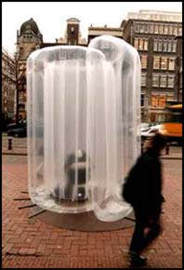
Agora Phobia (digitalis)
by Karen Lancel
Eyebeam presented the U.S. premiere of Agora Phobia (digitalis), a physical and online art project that questions mental images of being (un)safe and isolated. The physical component was installed on the street in front of Eyebeam's Chelsea facility in 2000. Created by Dutch artist Karen Lancel, Agora Phobia Digitalis invites the audience into a semi-transparent, inflatable Isolation Pillar which contains an online computer. Only large enough for one person to enter at a time, participants can feel the crowd outside but can only vaguely see shapes and figures around them. Inside one feels very safe within an intimate space, and at the same time, lacking contact with the outside. Viewers inside the pillar may participate in an internet-dialogue with people living in isolation elsewhere: a prisoner, a nun, a digipersona, a prisoner of war (POW), someone suffering from agoraphobia. The resulting dialogue is published on www.agora-phobia-digitalis.org and is part of an archive of chatsheets, performances, and installations. Agora Phobia Digitalis examines fluctuating notions of security in private and public spaces both physical and virtual.
Posted by michelle at 12:16 PM | Comments (0)
Pedestrian Cinematic Experience
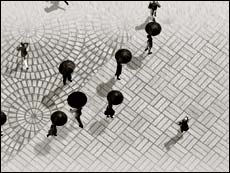
Pedestrian by Shelley Eshkar and Paul Kaiser
February 13 - March 23, 2002:
Pedestrian is a public art project of site-specific, projected installations presented simultaneously in three locations in New York City - in the galleries at Eyebeam in Chelsea and at two outdoor venues; at Rockefeller Plaza in Midtown, and The Studio Museum in Harlem.
Created by artists Shelley Eshkar and Paul Kaiser and co-produced by Eyebeam and Art Production Fund, Pedestrian presents miniature, computer-generated moving figures projected directly onto the ground from above, providing a bird's-eye view of pedestrian traffic. These projected "pedestrians" interact to form patterns, crowds and streams that evolve unpredictably, almost organically, as if having lives of their own. Figures stand, watch, meet, sit, push, move away, sometimes run, or perhaps even lie down according to spontaneous rules of motion and engagement. Pedestrian builds on advanced technology, combining motion-capture, 3-D modeling software, texture mapping to visually enrich surface detail, behavioral rules devised by the artists to drive the action, and an overarching cinematic framework.
Pedestrian depicts a solid and almost tactile world within the pavement you walk upon. It's medium is that of a projected image directly onto the pavement. Instead of a sober rectangle, spectators form a dynamic human perimeter around the work. These are conscious choices to emphasize the work's physicality, and to have our own presence essentially complete the artwork; we and Pedestrian generate a unique crowd footprint in the real world.
By projecting Pedestrian onto public sidewalks, the artists experiment with cinematic experience in the context of public sculpture. Viewers see a bird's eye view of 3D modeled plazas and figures that are mapped with texture samples gathered and scanned from the real world. All movement is built from a library of motion-captured data that is mapped onto synthetic characters. The final projection shows a miniature depiction of real - life motions and the daily public interactions of figures representing various urban archetypes. The distorted foreshortening of an aerial perspective of doll-like figures and plazas are suggestive of surveillance or video games in which we play out constantly changing narratives and dialogue that will continue outside of our current viewpoint
Featured in the ZKM book Future Cinema.
Posted by michelle at 11:19 AM | Comments (0)
August 01, 2004
Tele-Actor
Hello all:
I am really amazed by the amount of activity on the blog -- looks like we've hit on a potent topic.
One project I want to add to the mix is Ken Goldberg's Tele-Actor , which is now about two years old. People online vote on what they want an actor to do. That actor is equiped with a wearable computer, including cams, mics, etc.
From the website: "The "Tele-Actor" is a skilled human with cameras and microphones connected to a wireless digital network. Live video and audio are broadcast to participants via the Internet or interactive television. Participants not only view, but interact with each other and with the Tele-Actor by voting on what to do next. Our "Spatial Dynamic Voting" (SDV) interface incorporates group dynamics into a variety of online experiences."
It seems to me that many of the pieces mentioned so far not only are networked or distributed in nature, but also utilize non-linear narratives that have not been been predetermined. Coincidence?
Brooke
Posted by at 10:04 PM | Comments (1)
Mixed Reality in Los Angeles
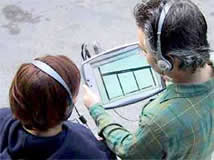
GPS Walkabout
34 North 118 West plays through a Tablet PC with Global Positioning System receiver and headphones. GPS tracks your location to determine how the story unfolds - in real time, in real space, as you traverse the sidewalks of Los Angeles.
Description of Tour: Imagine walking through the city and triggering moments in time. Imagine wandering through a space inhabited with the sonic ghosts of another era. Like ether, the air around you pulses with spirits, voices, and sounds. Streets, buildings, and hidden fragments tell a story. The setting is the Freight Depot in downtown Los Angeles. At the turn of the century Railroads were synonymous with power, speed and modernization. Telegraphs and Railroads were our first cross-country infrastructures, preceding the Internet. From the history and myth of the Railroad to the present day, sounds and voices drift in and out as you walk. Read Narrative Archaeology by Jeremy Hight.
Posted by michelle at 06:07 PM
O.U.T. There
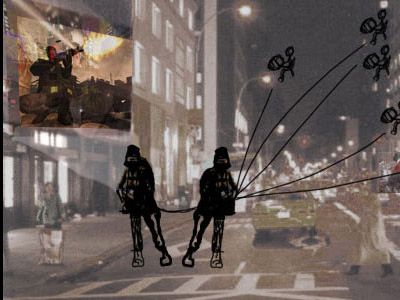
Two women in gear are on the ground. One with a laptop and the other with a projector pointing onto building walls in 3 key locations in the city. They are connected through a mobile wireless bicycle to an online team of five game players located around the world. They intervene on servers in a popular online military simulation game with performance actions carried out by the whole team. The live projections in the city can also be viewed through a web cam on the OUT website.
OUT takes its name from MOUT a military term for Military Operations in Urban Terrain. Many military simulation computer games implement MOUT. For example, the US Army developed game Full Spectrum Warrior trains gamers in MOUT combat. OUT is a criticism of the increasing militarization of civilian life which has been implemented in the US and elsewhere since 911. The Patriot Act, surveillance of public libraries, and the increased powers of government to hold citizens in military custody without trial are instances of these increased powers of government instigated by the Bush administration. In an endless spiral war of terror a government is at war with its own citizens, with soldiers in the midst of the fabric of ordinary life, as has been the case for a while in terror alert cities like Tel Aviv and Jerusalem.
OUT is an artistic intervention in the public space of online games and cities. OUT is also happening at a moment when the street has become again a viable mode of expression. From Seattle to Cancun activists are using wireless technologies and the web to organize actions and and congregate. Dada-like agenda-less mobs have appeared in New York and spread to other cities, In contrast, police at these events are increasingly high tech and cyborgean. They wear the latest riot gear shields and padding and use high tech wireless communication systems. They move in sophisticated crowd control formations. OUT, on the other hand, is a high tech art intervention, art activists with high tech gear and strategy. OUT of the closet of MOUT.
Republicans OUT of New York. The United States OUT of Iraq and the Middle East. Escalating worldwide Militarism and Violence, from whatever source, (right wing oil hungry U.S. capitalists or wealthy Islamic fundamentalists), OUT of Civilian Life. The U.S. Army and Pentagon computer game developers OUT of the minds of prebuscent gamers.
Posted by michelle at 03:45 PM | Comments (0)
Distributed Opera
The BRAIN OPERA
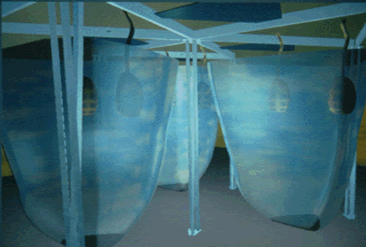
Premiered in 1996, this interactive, musical journey was presented simultaneously in physical and cyber space. A viewer could perform live in the Brain Opera performances via " T h e P a l e t t e," musical instrument. This advanced, multi-user Java applet, was only active during Brain Opera performances. You could also see and hear live video and audio broadcasts of the Brain Opera performances.
The culmination of the Brain Opera experience was the 45-minute Final Performance--a 3-movement composition tied together the project's many musical, visual, and textual strands into a unified tapestry. Three performers shape, select, and interpret precomposed and audience-created elements, using specially-designed hyperinstruments: the Sensor Chair (which translates wireless body movement into sound); the Gesture Wall (a modification of the same instrument from the Mind Forest); and the Digital Baton (which combines pointing, squeezing/selecting, and motion sensing). A large curved screen and multiple projectors allows a constant flow of images to be presented in coordination with the music, illustrating Minsky's words, providing counterpoint to the music, or illuminating the actions of the performers. The audience is also invited to dance on a Sensor Carpet during the Finale, adding sound to the richness and intensity at the end of the work.
Posted by michelle at 04:51 AM
